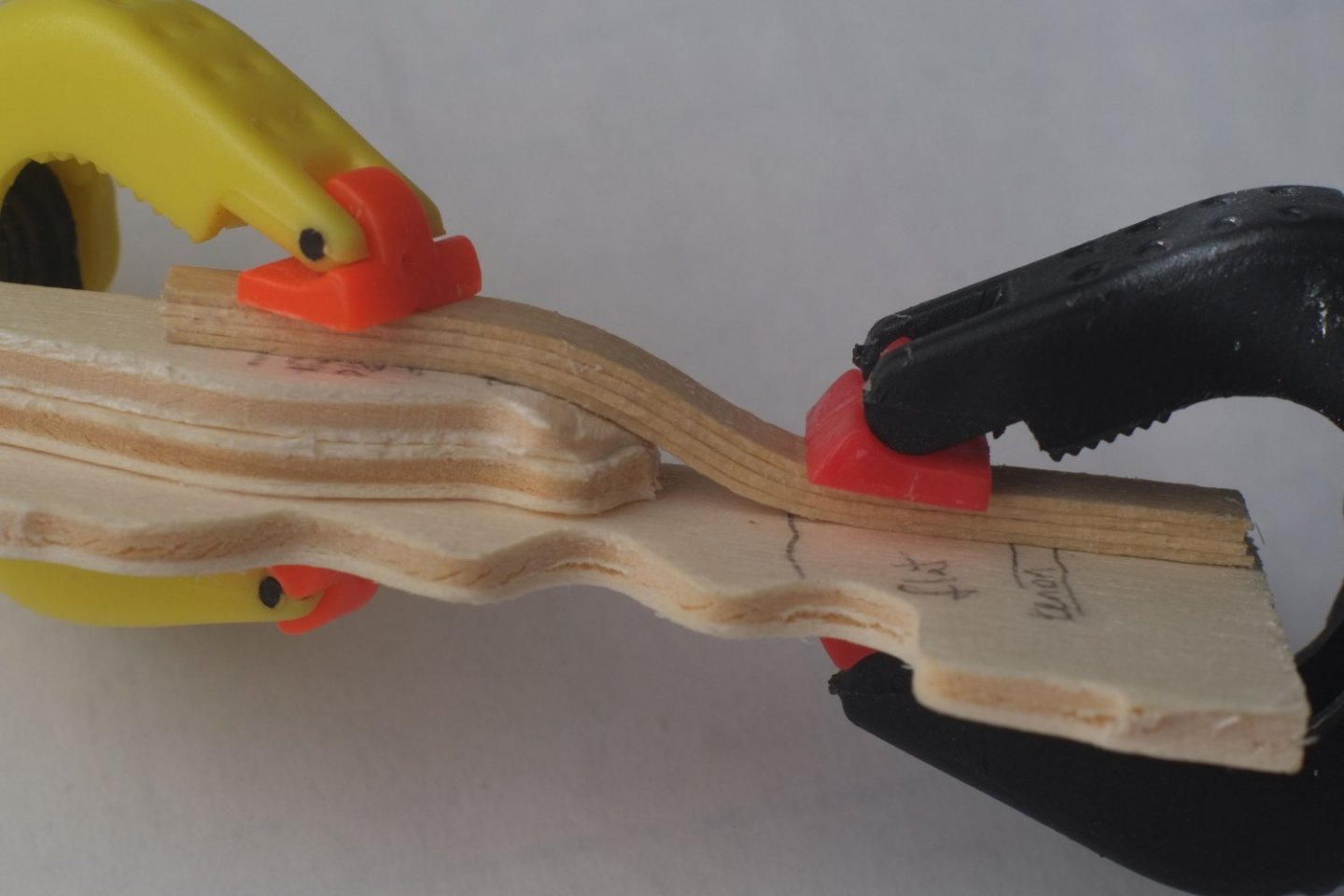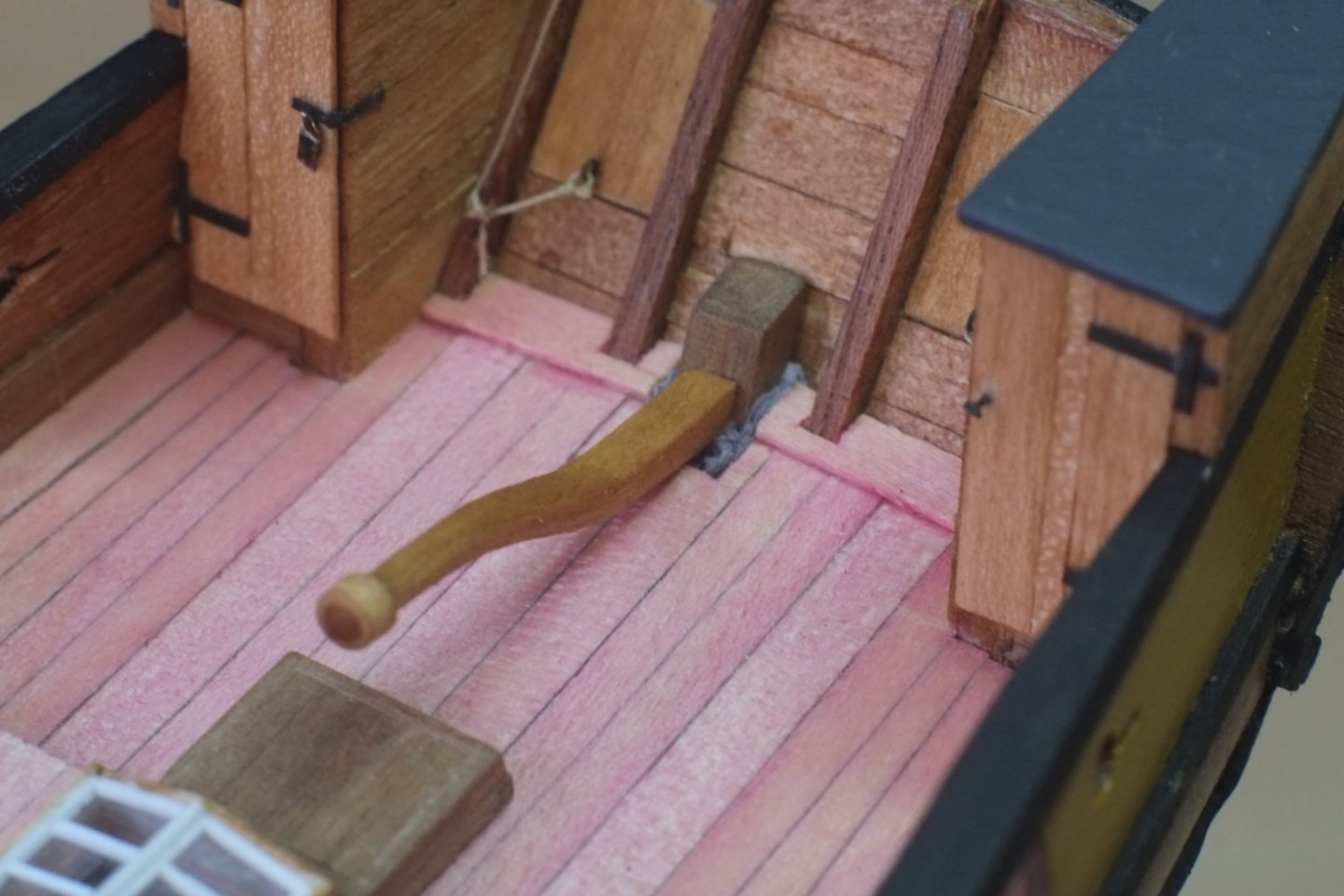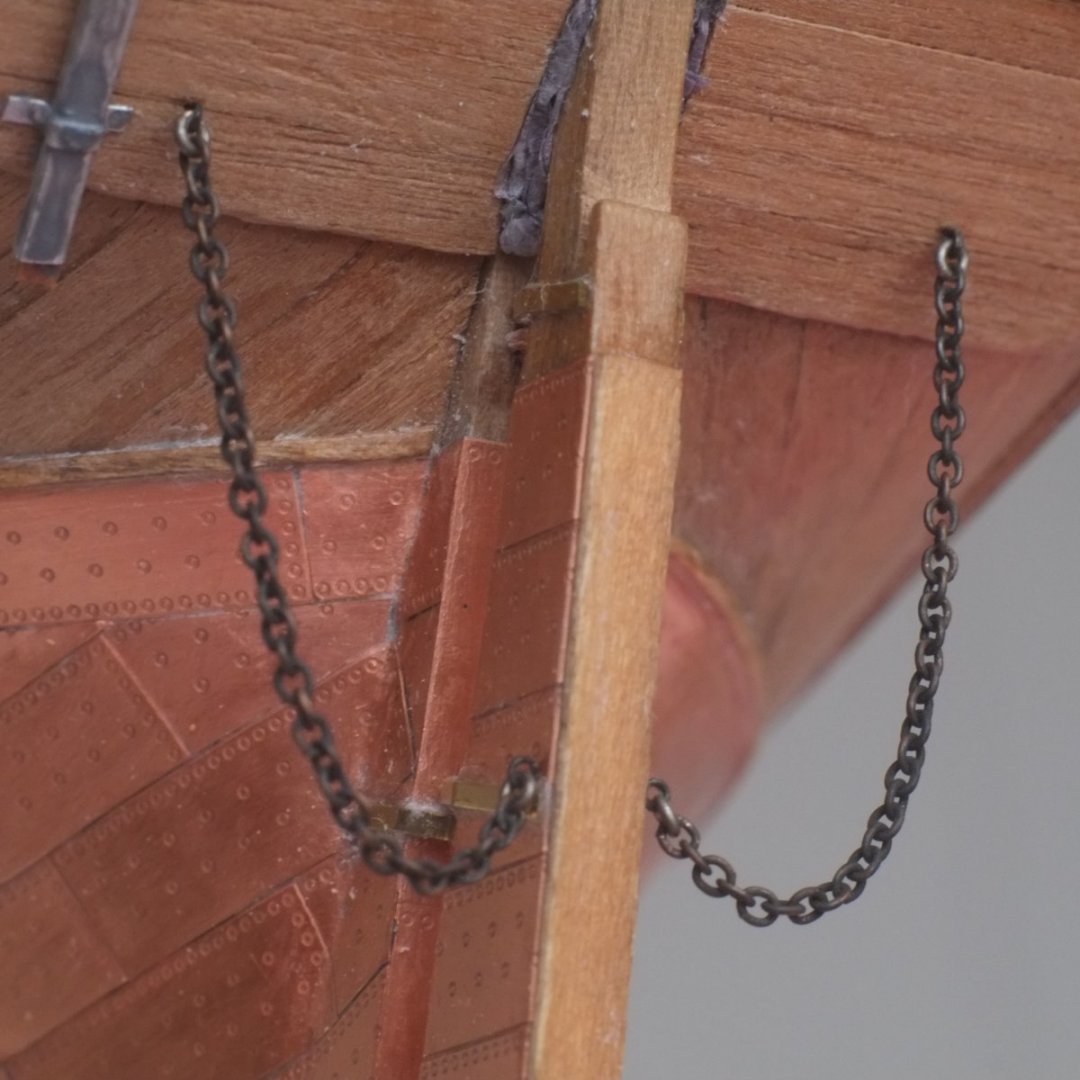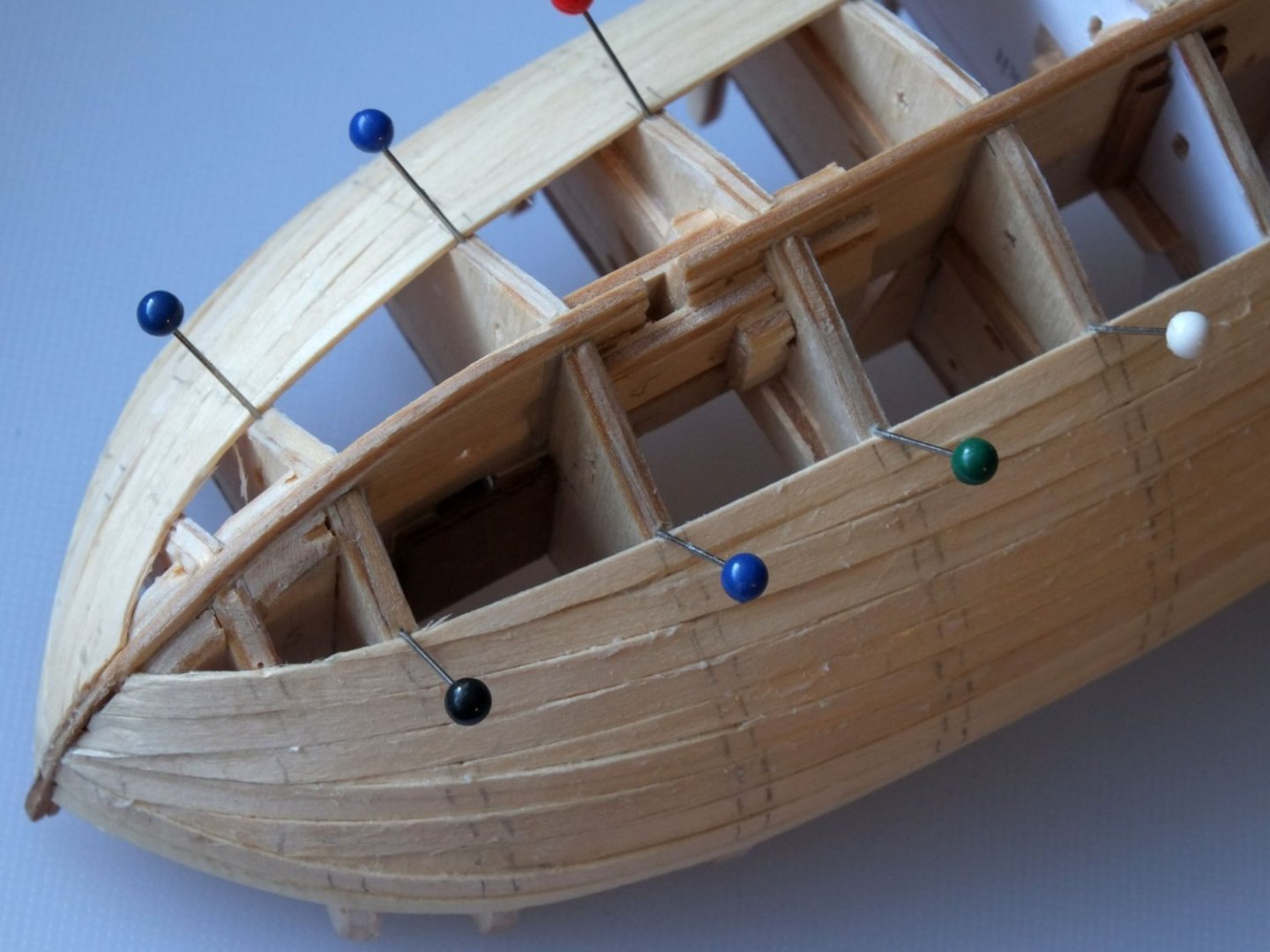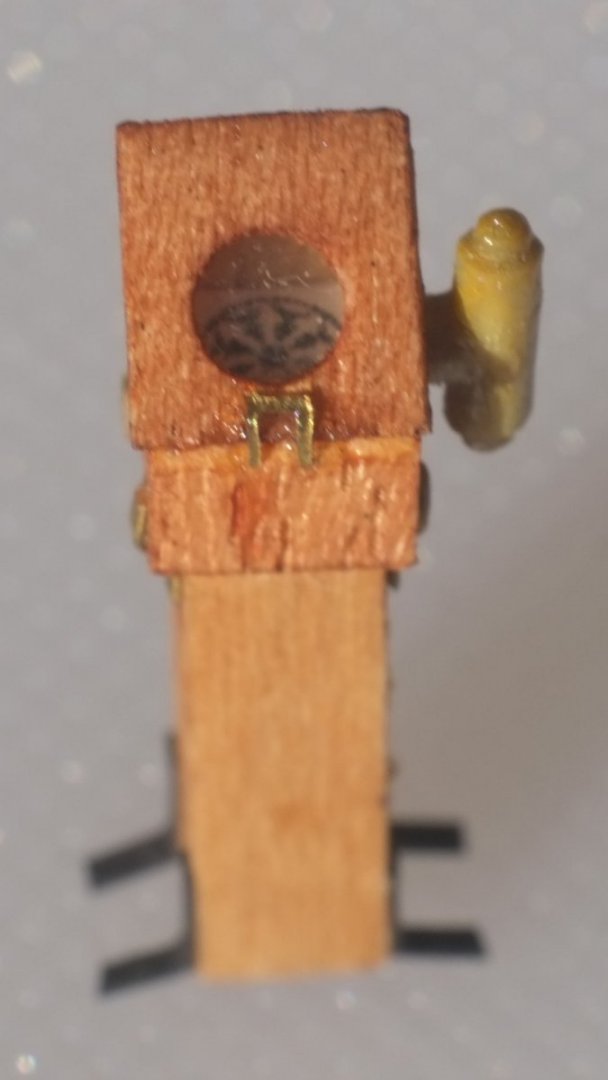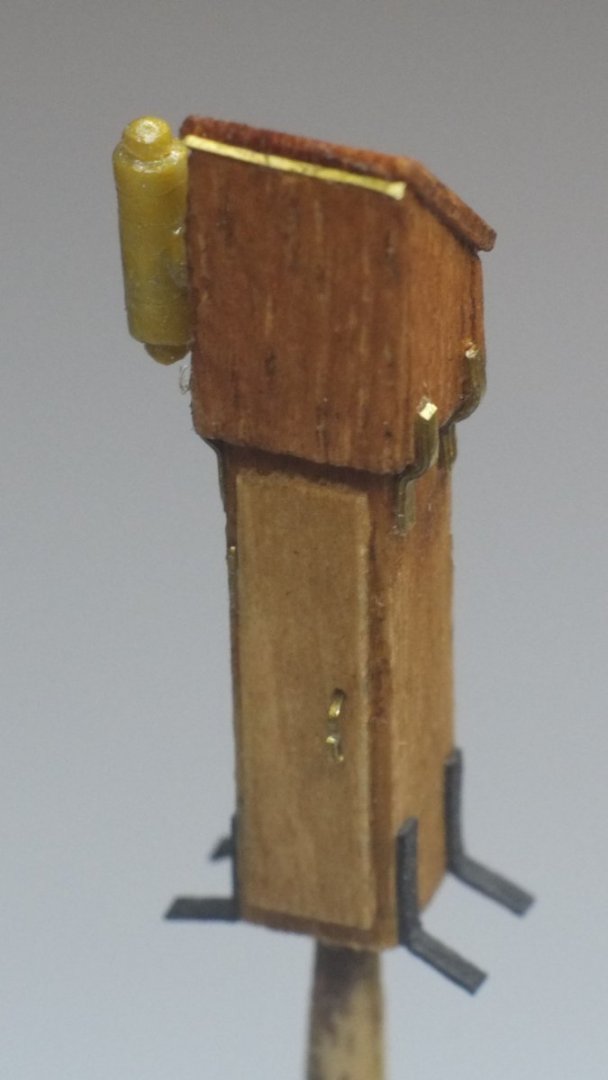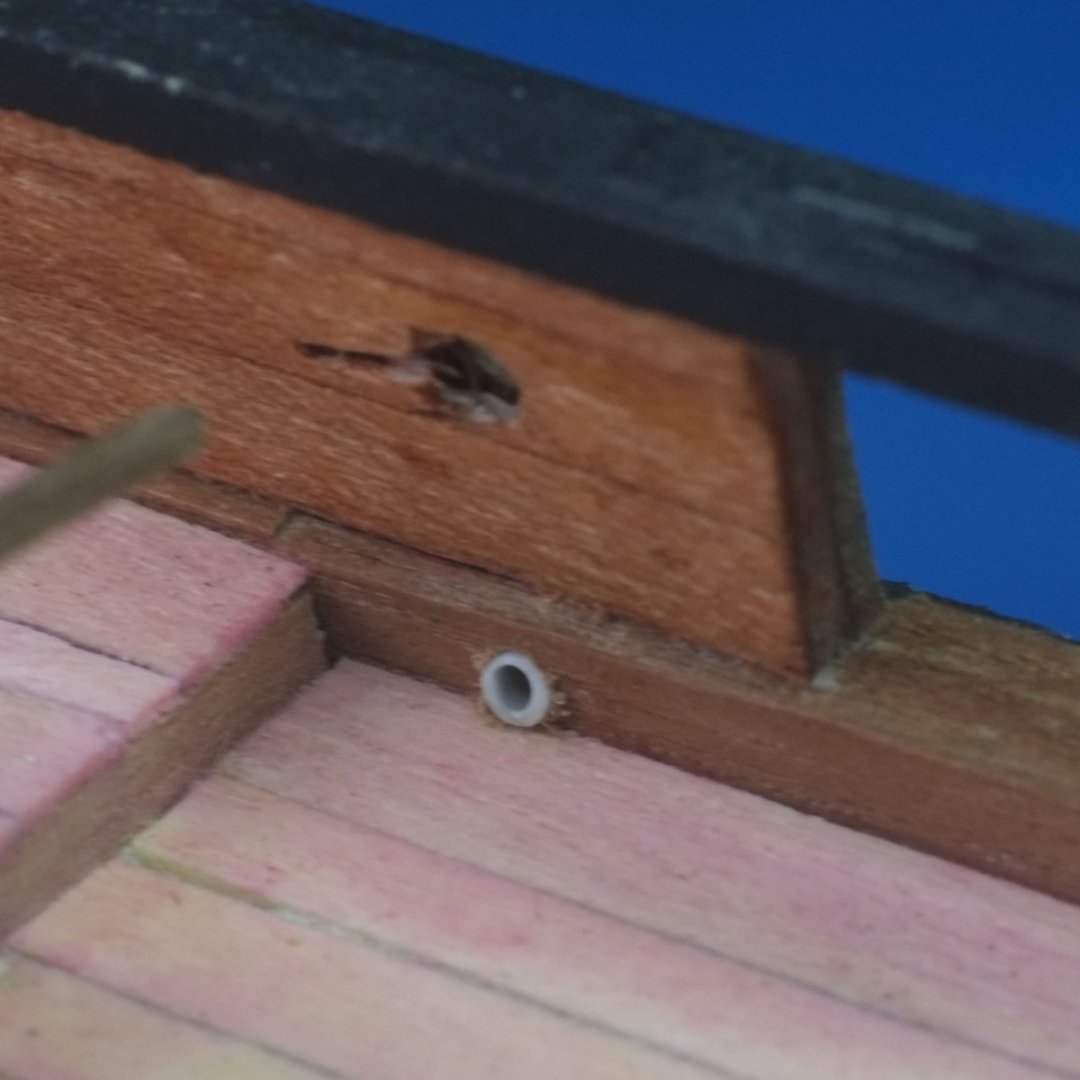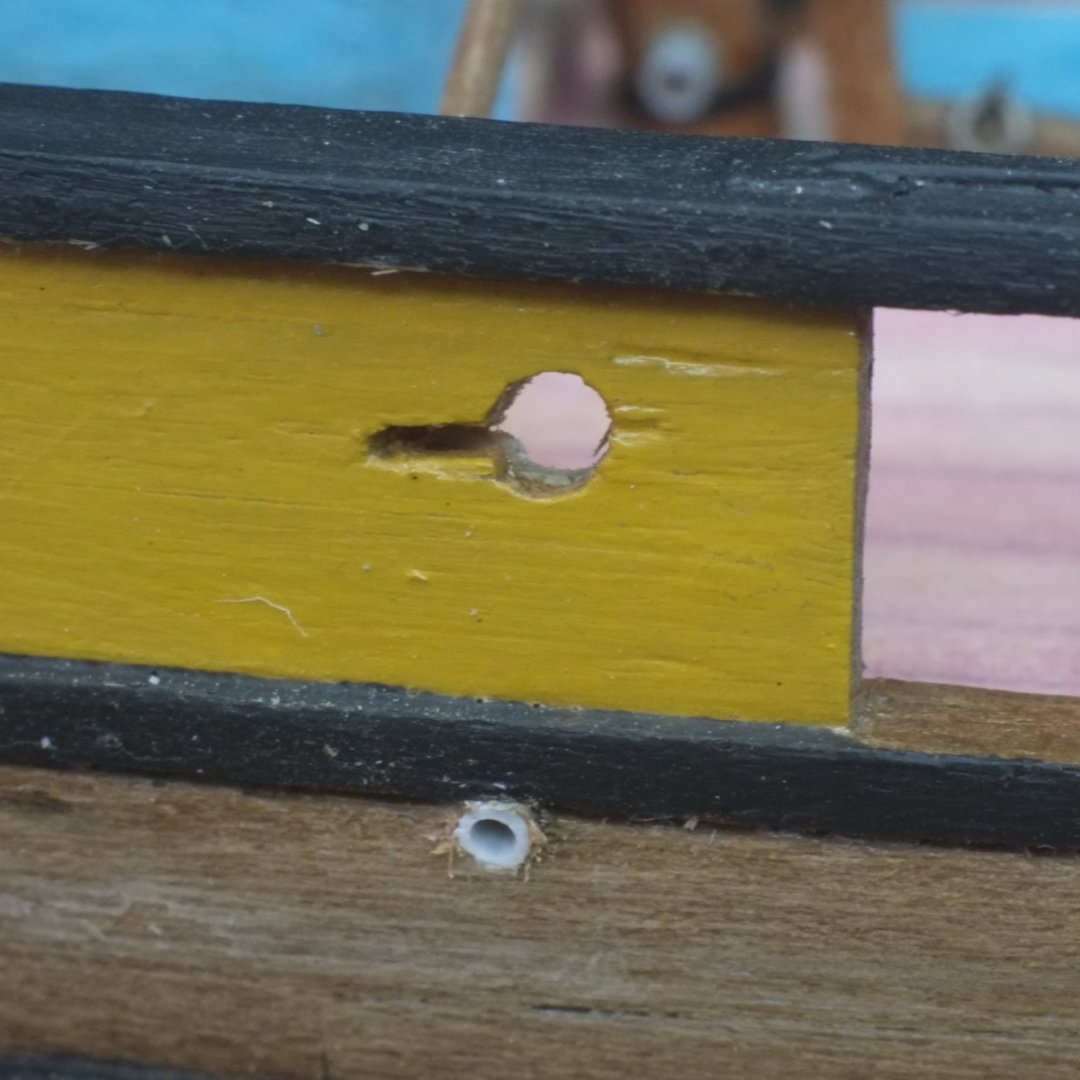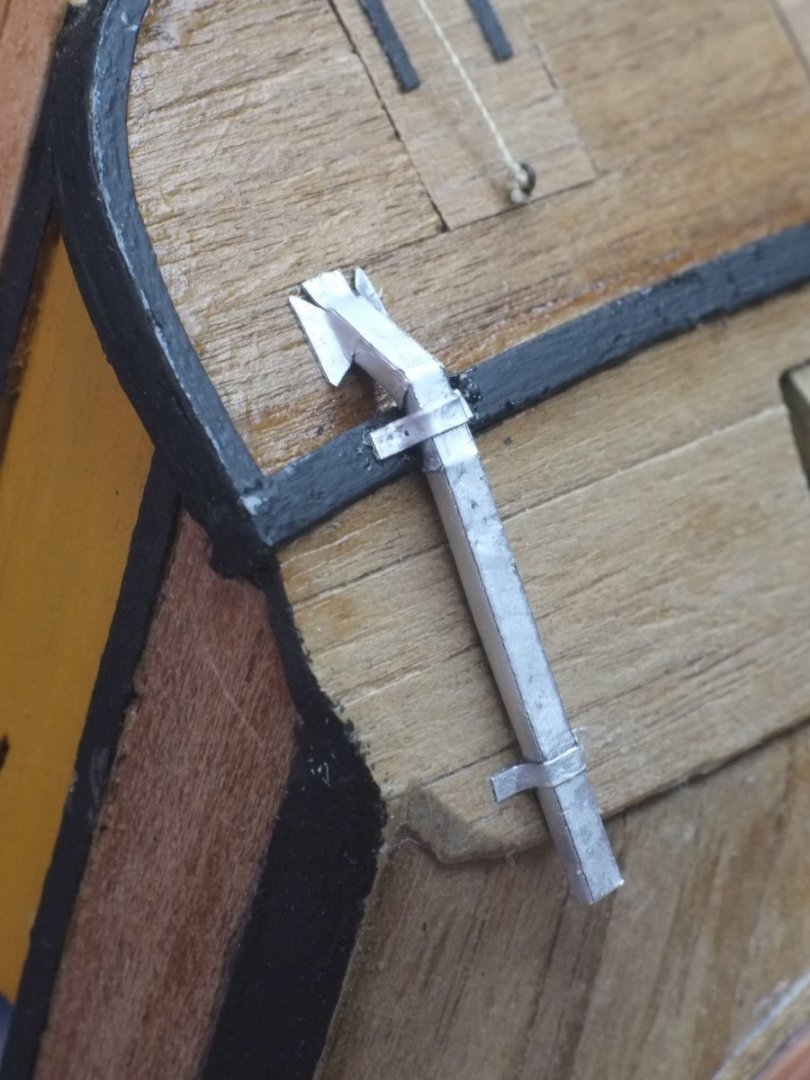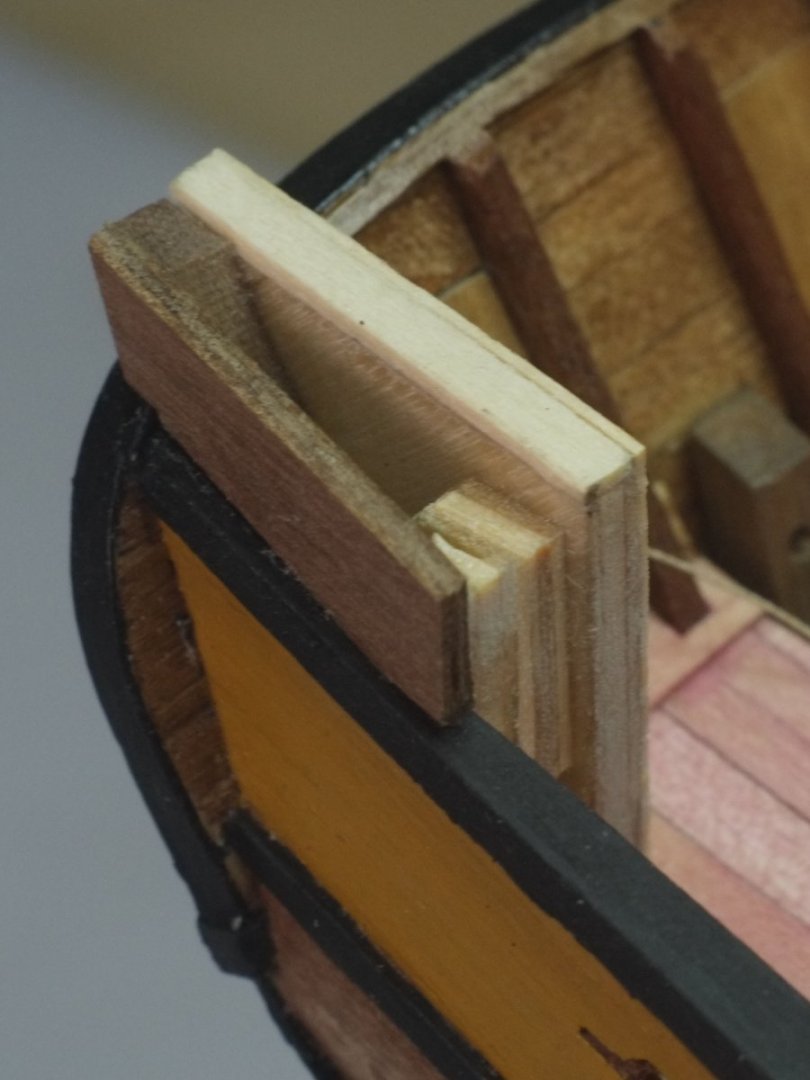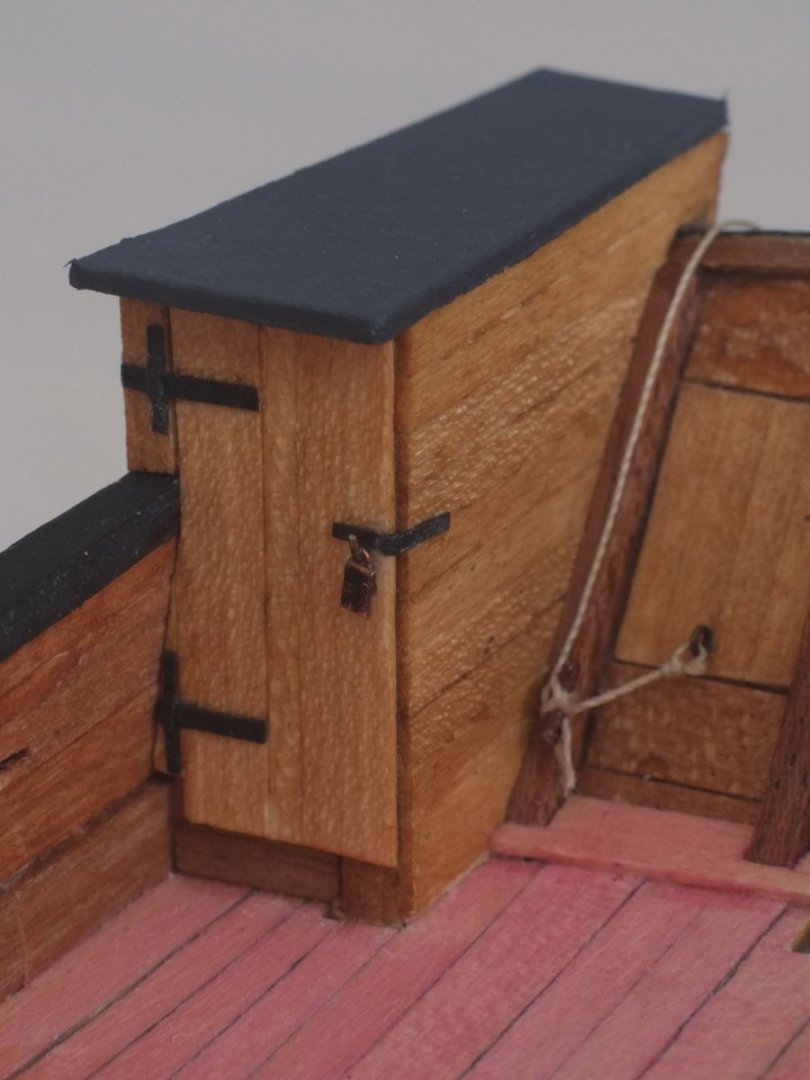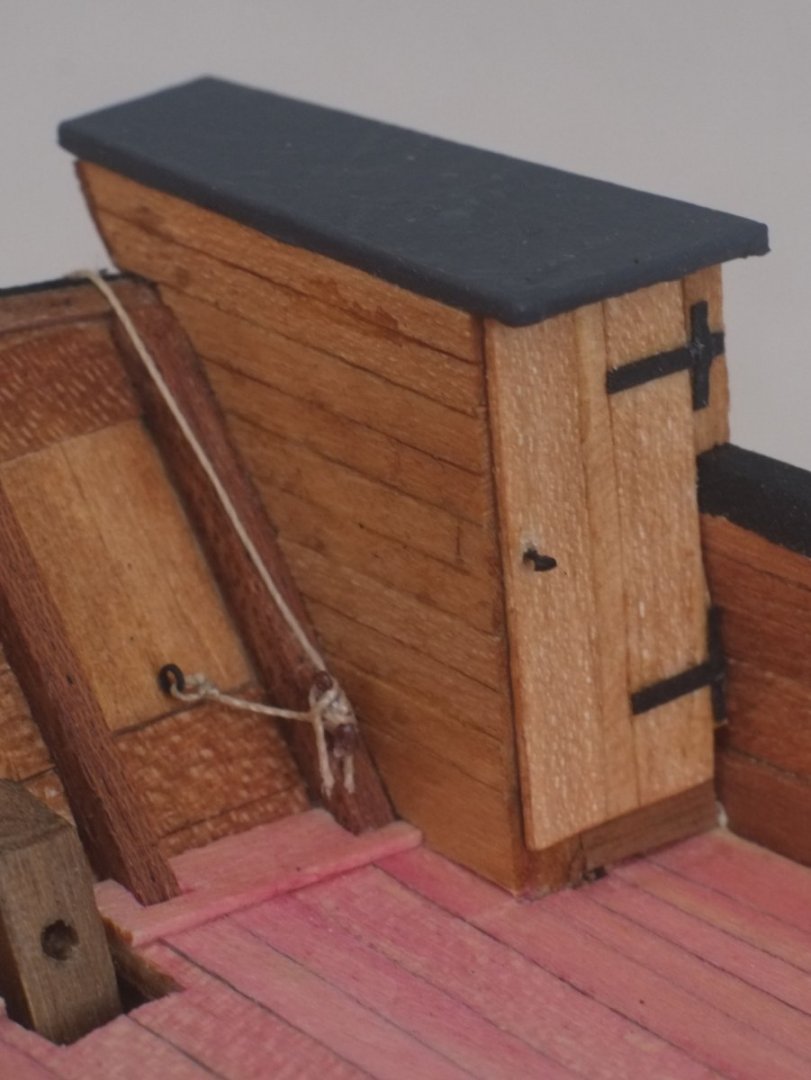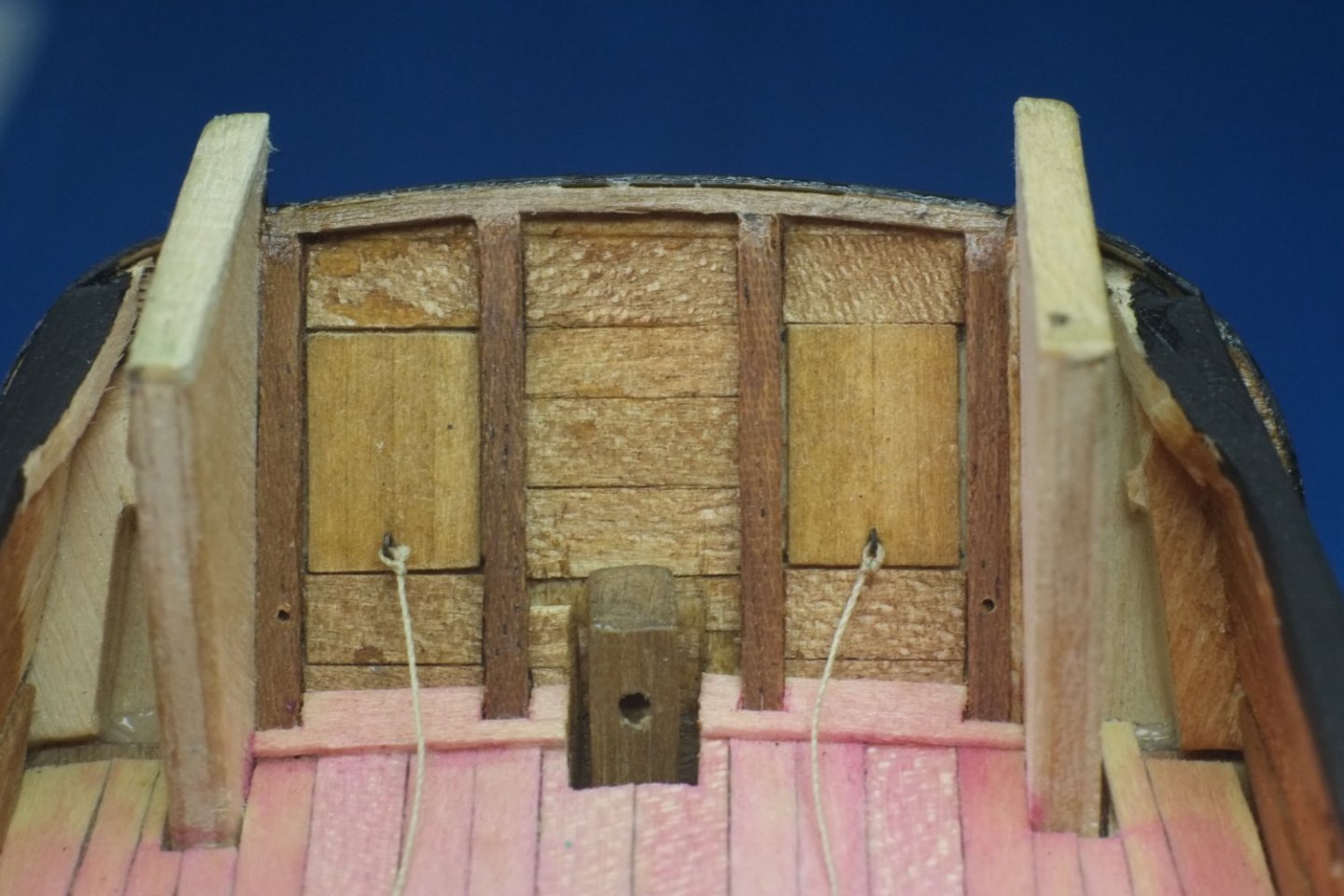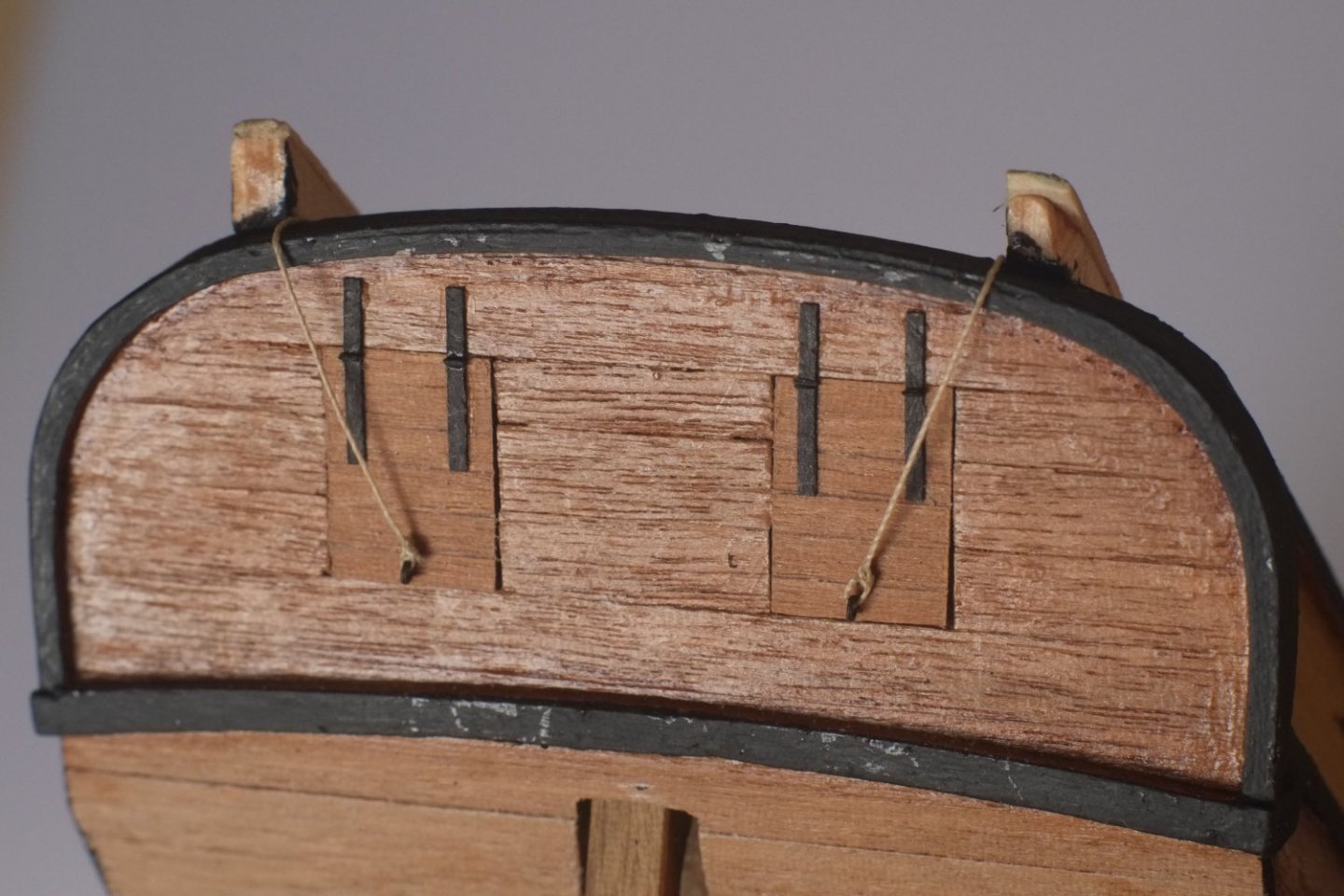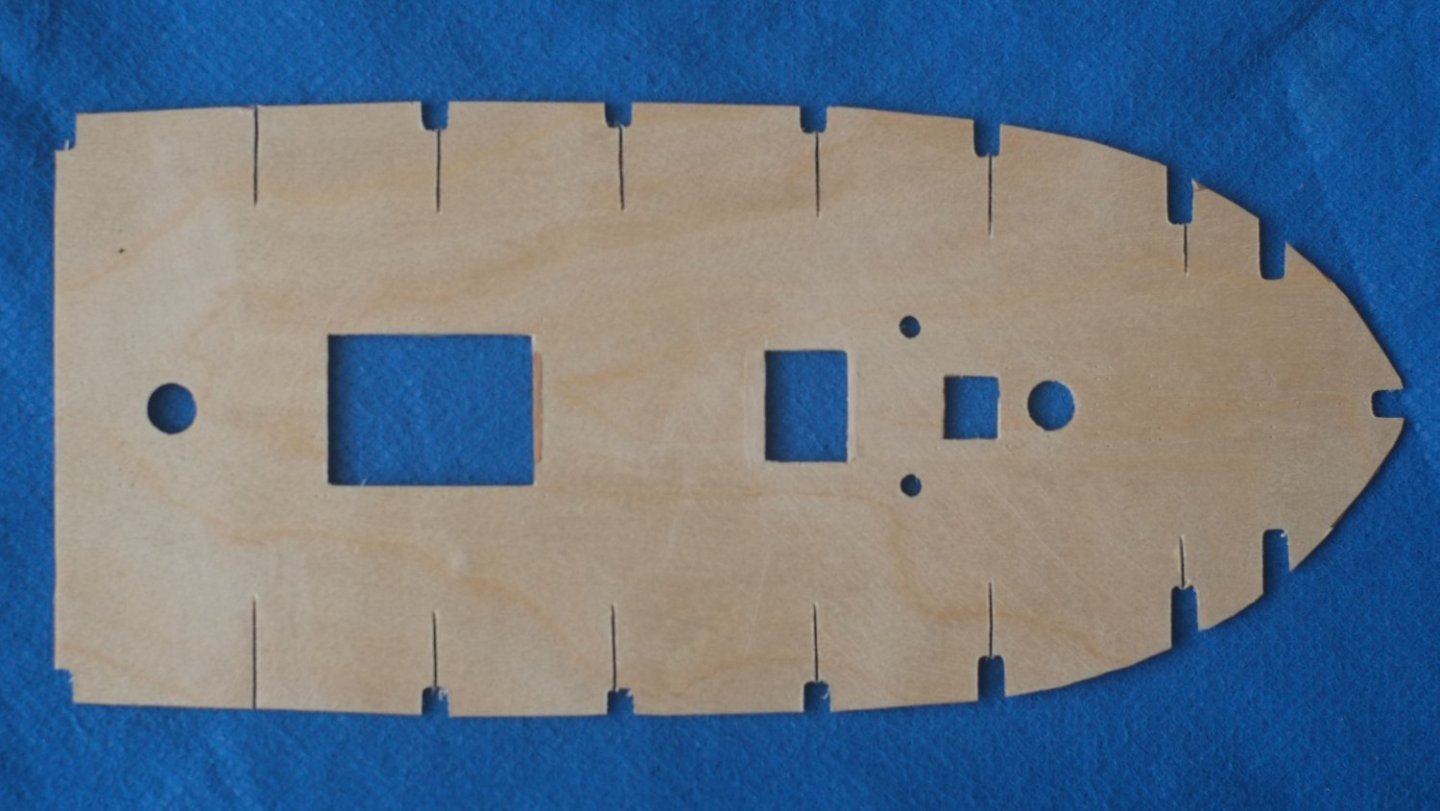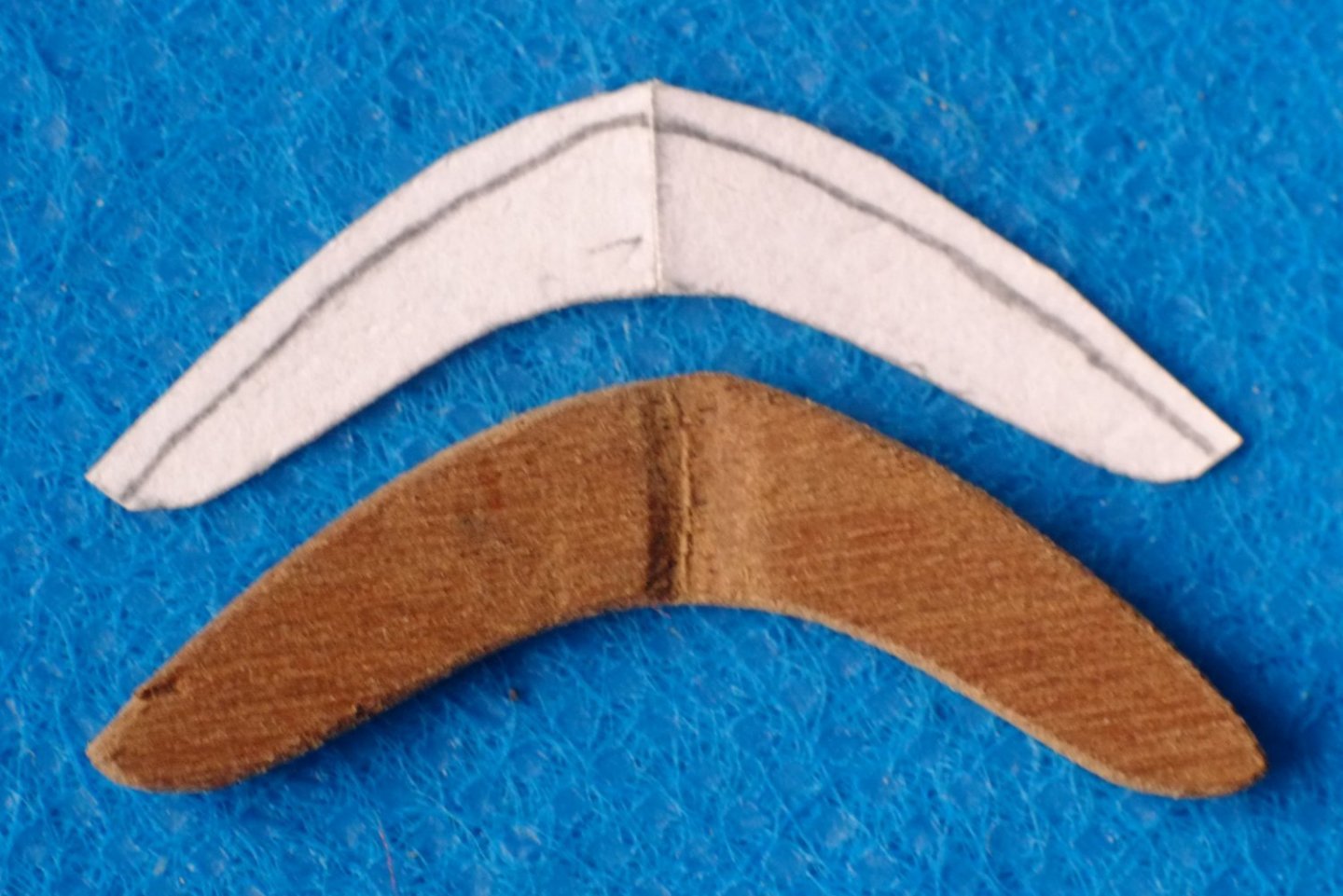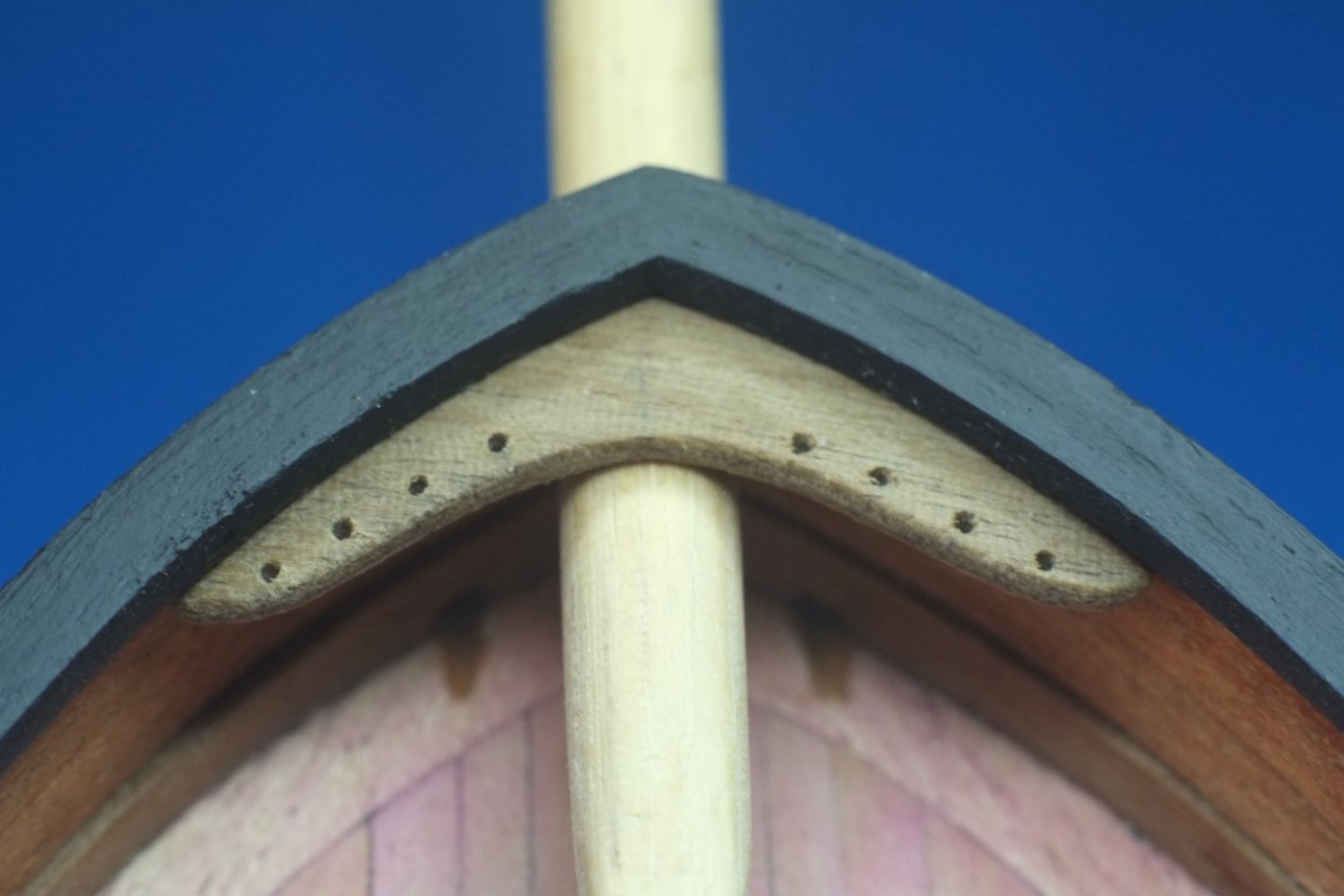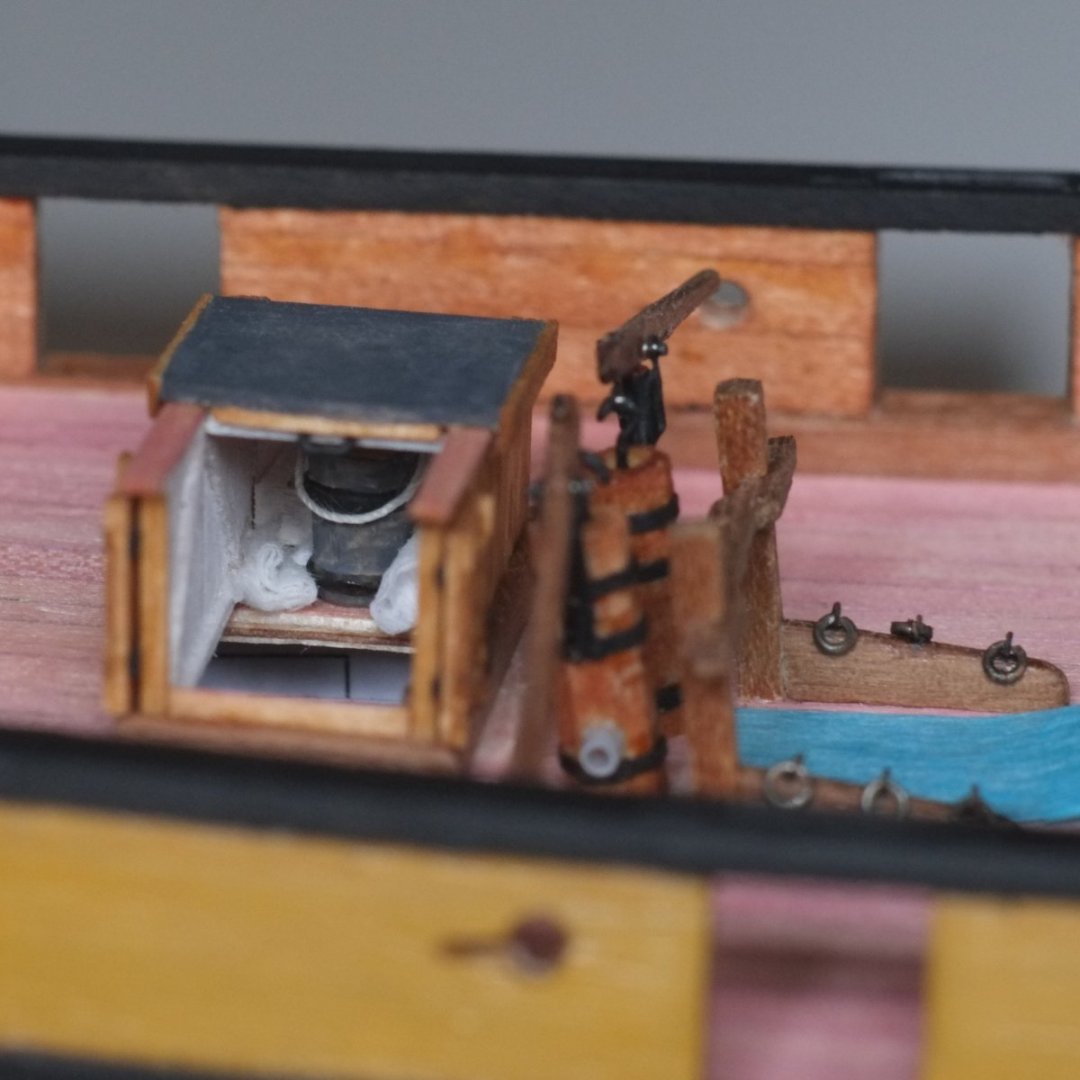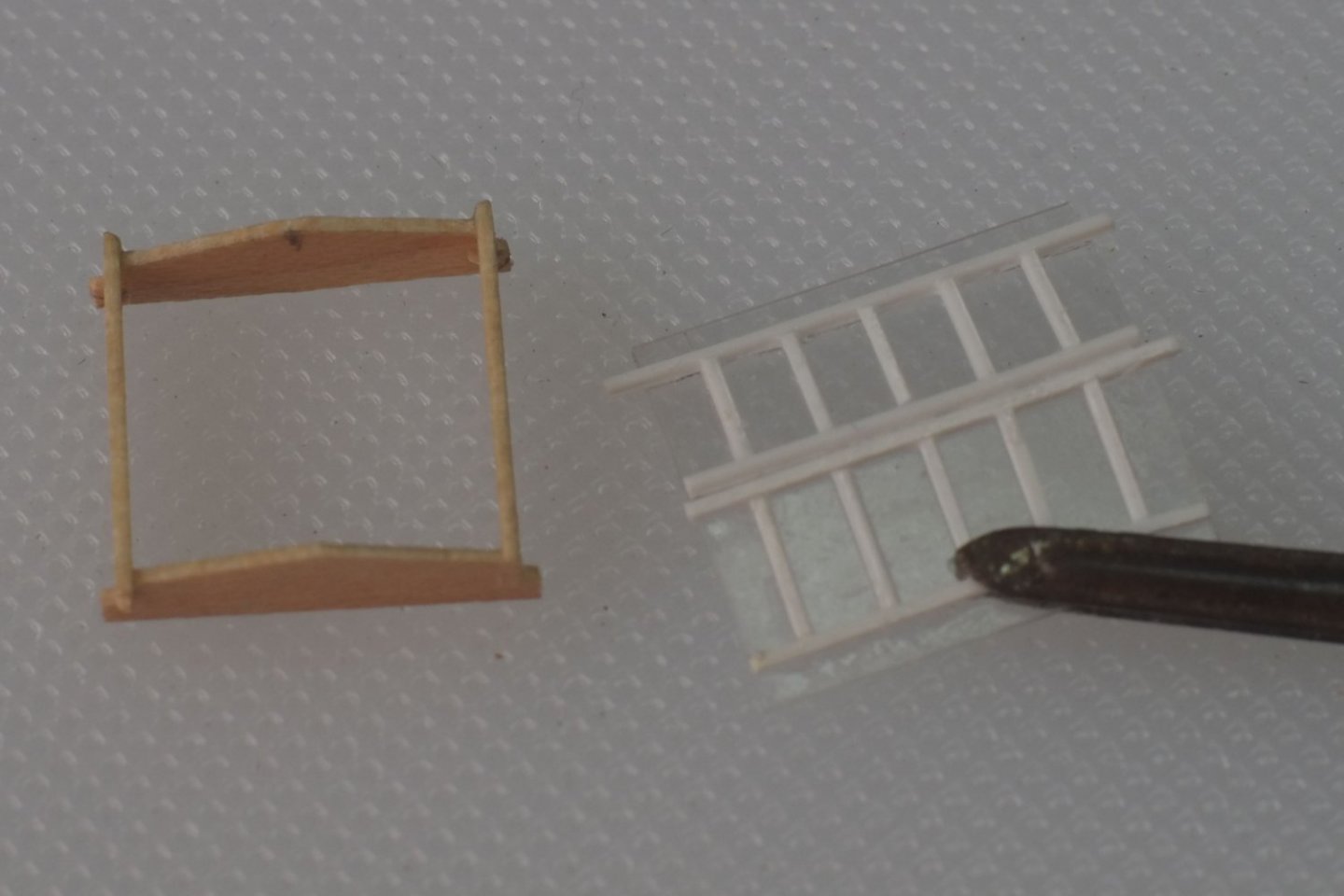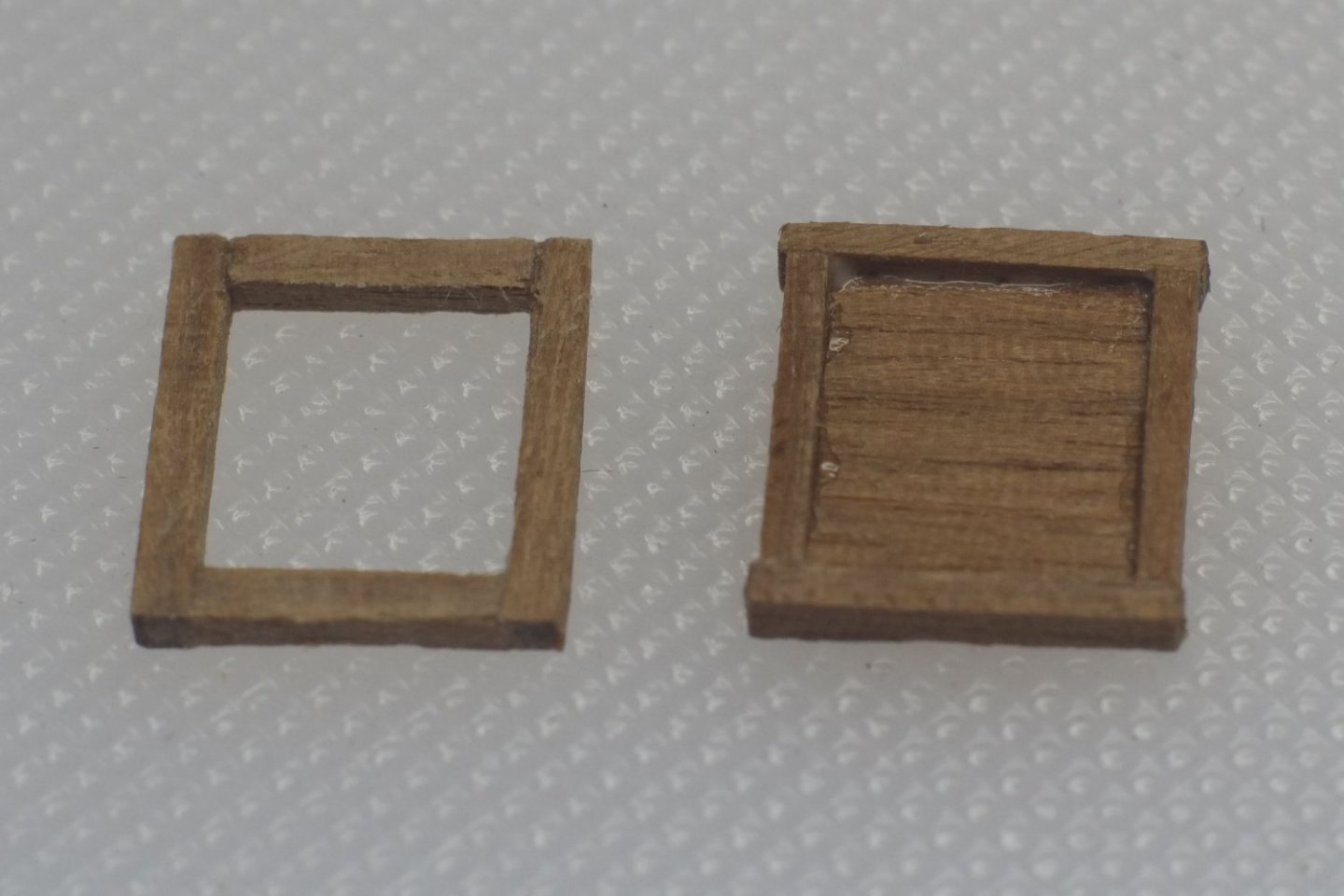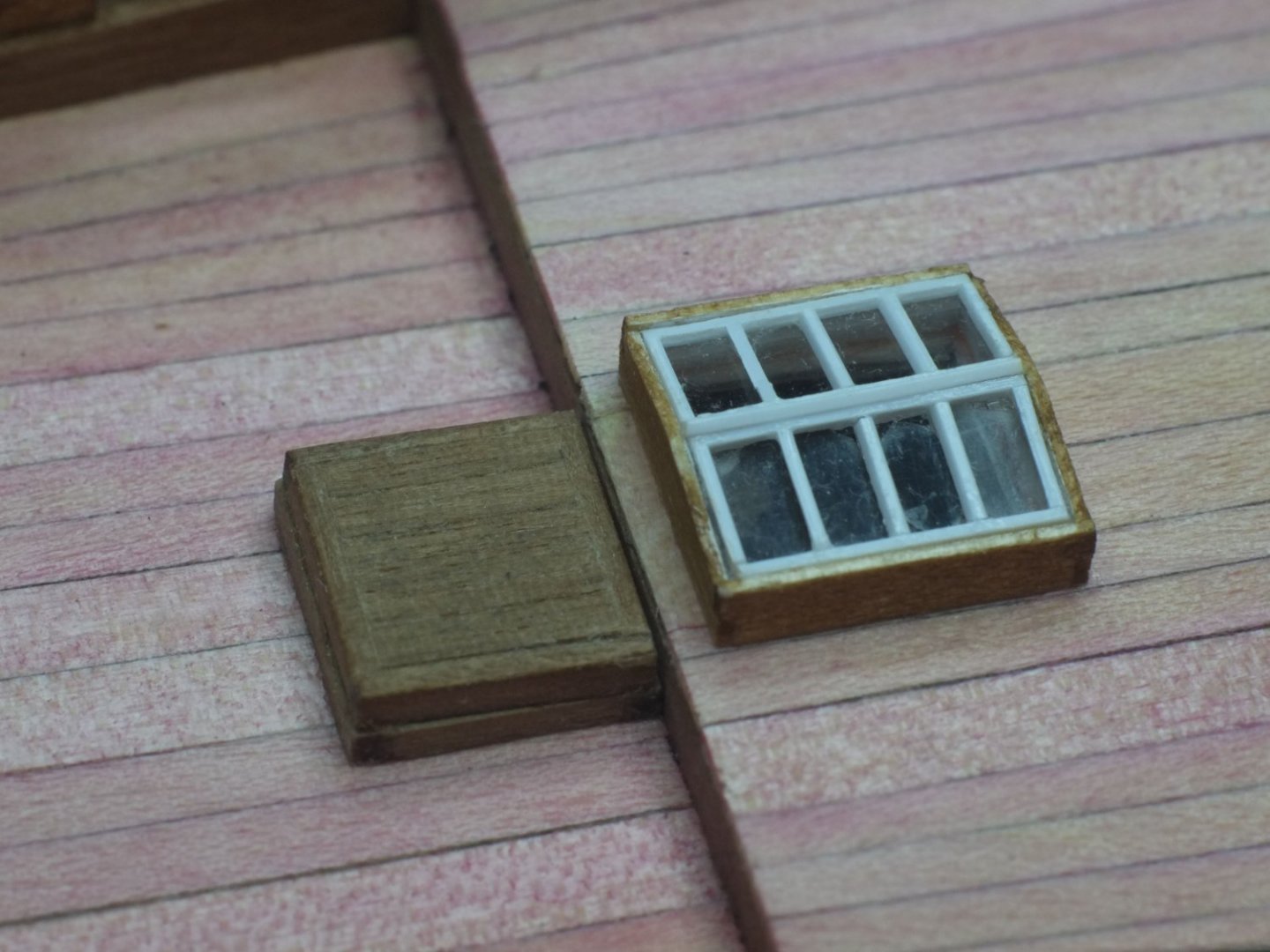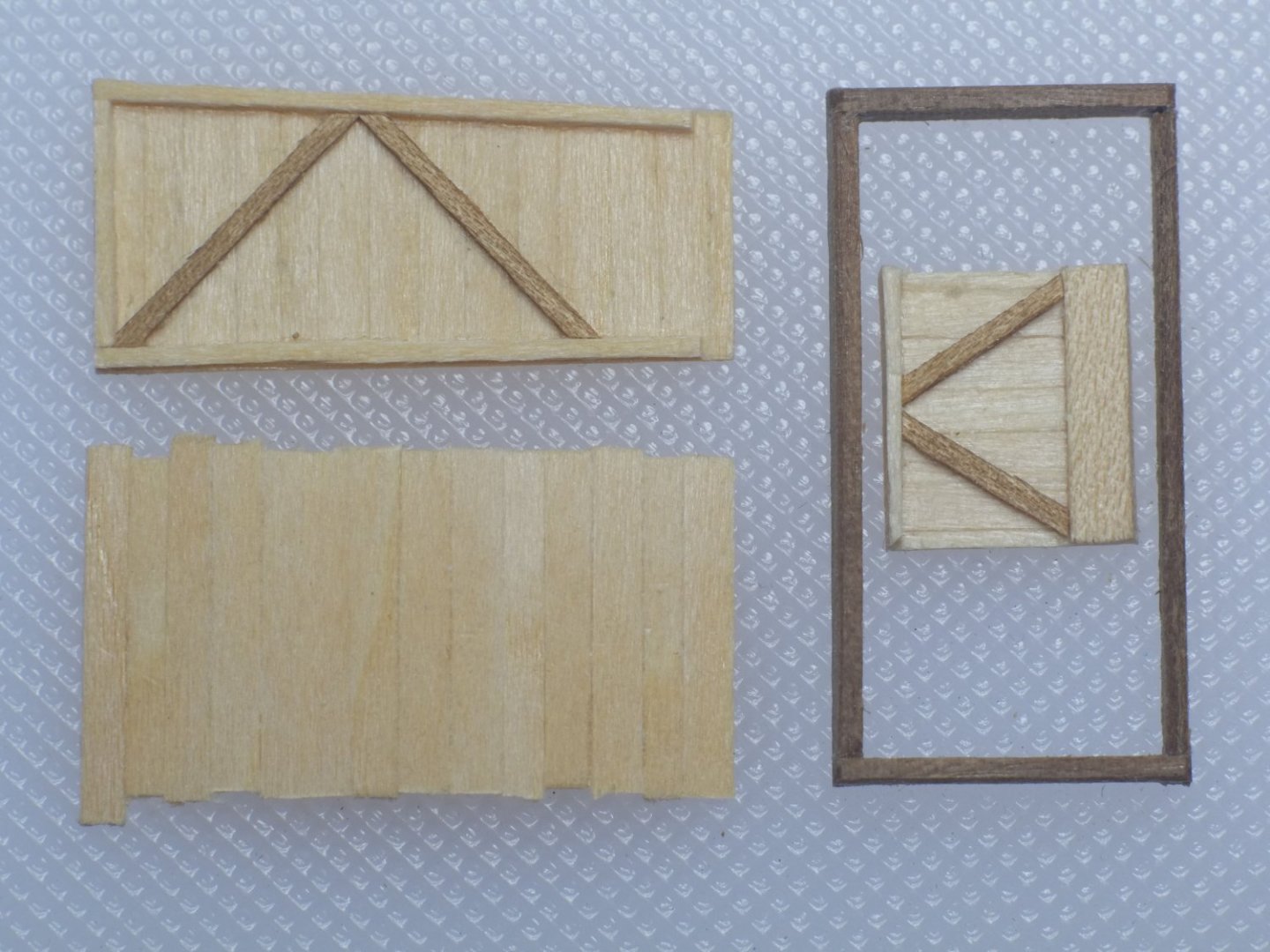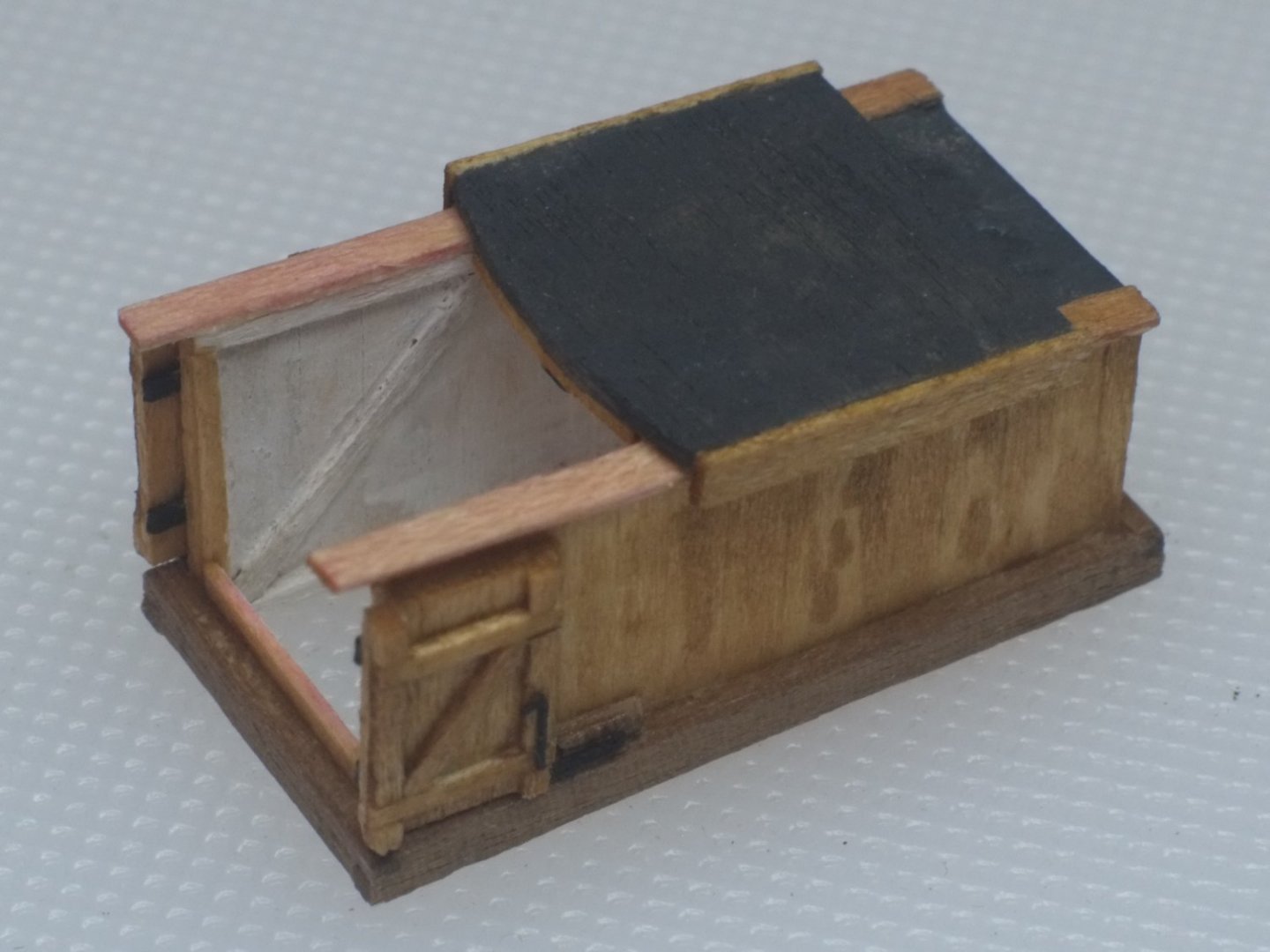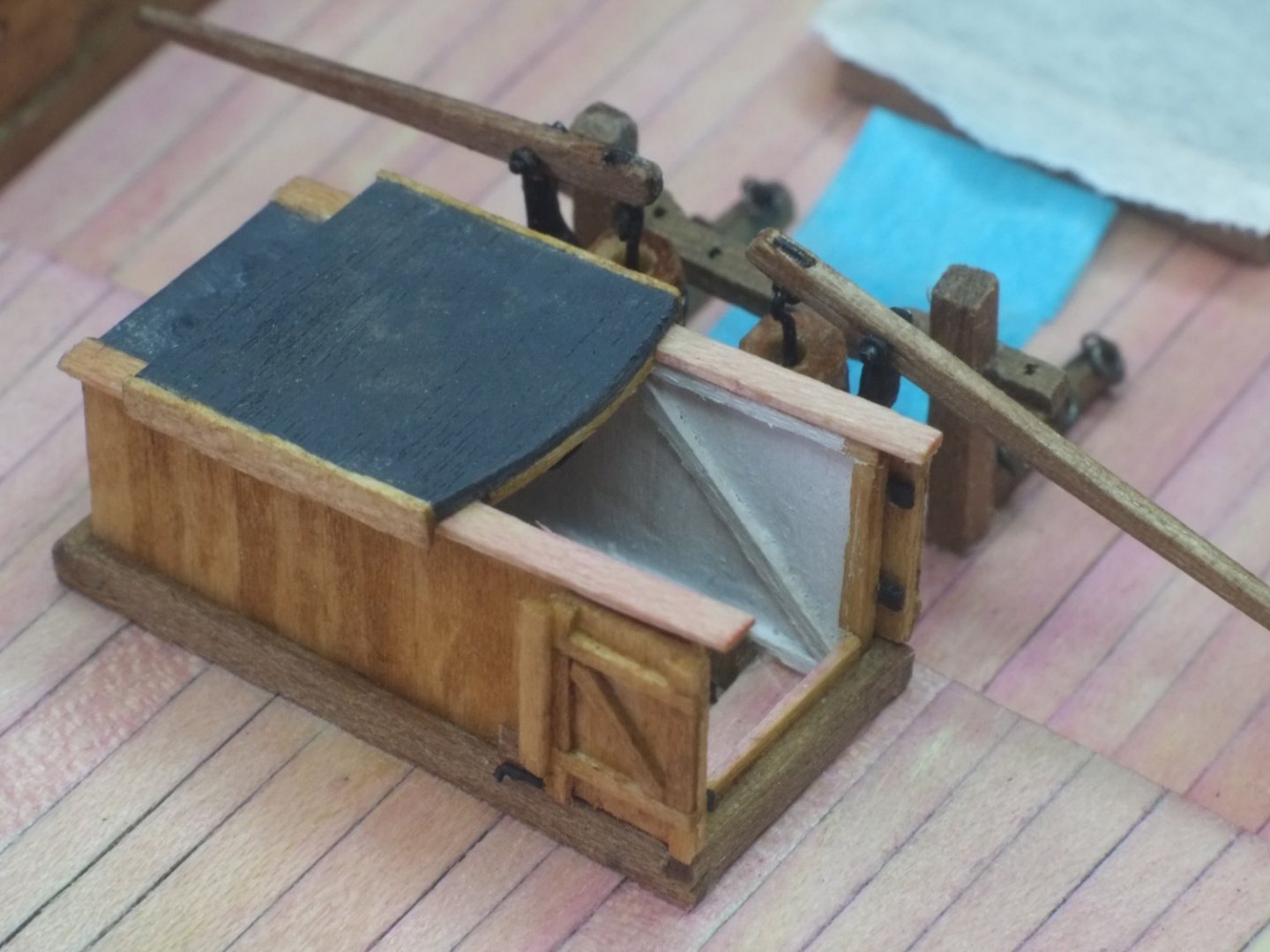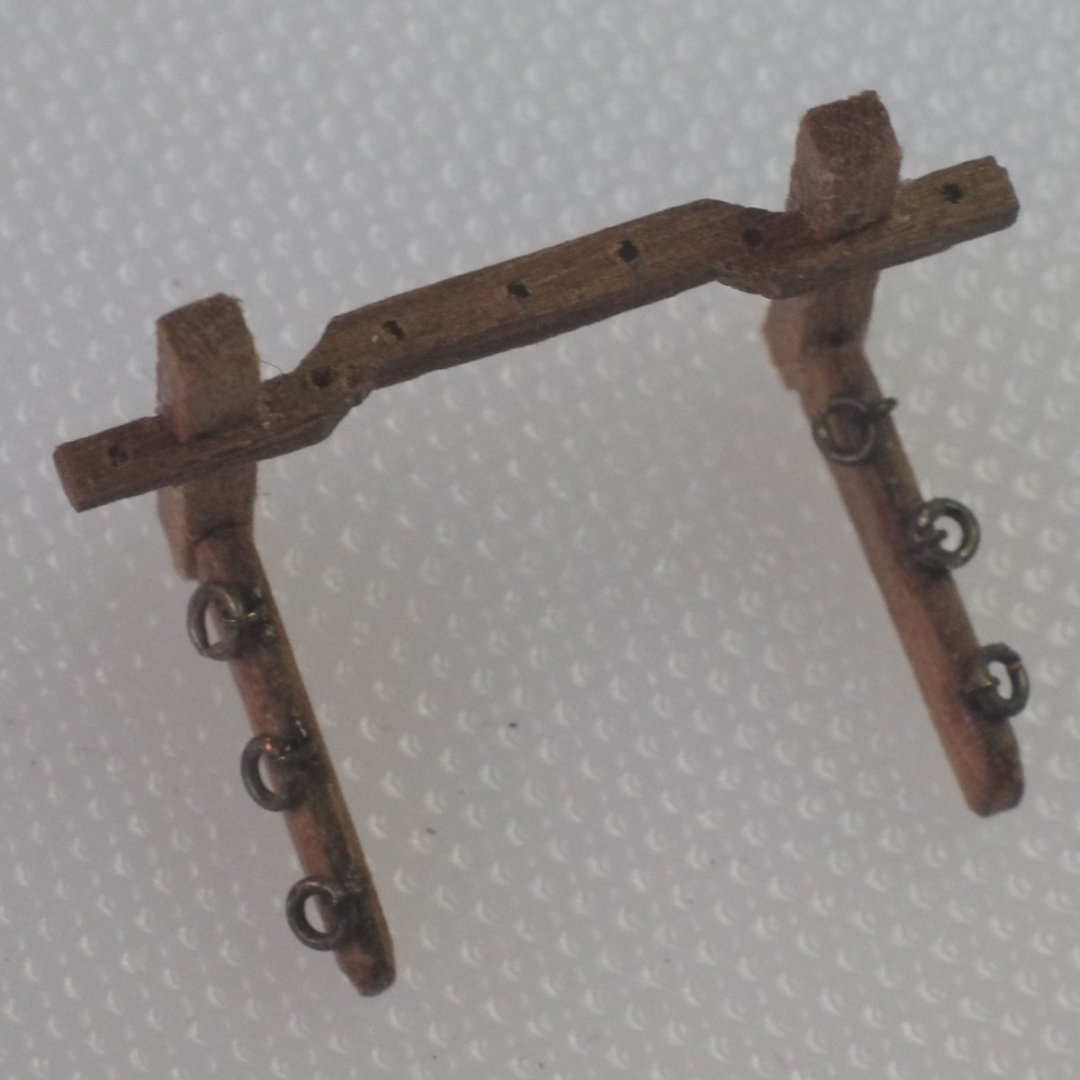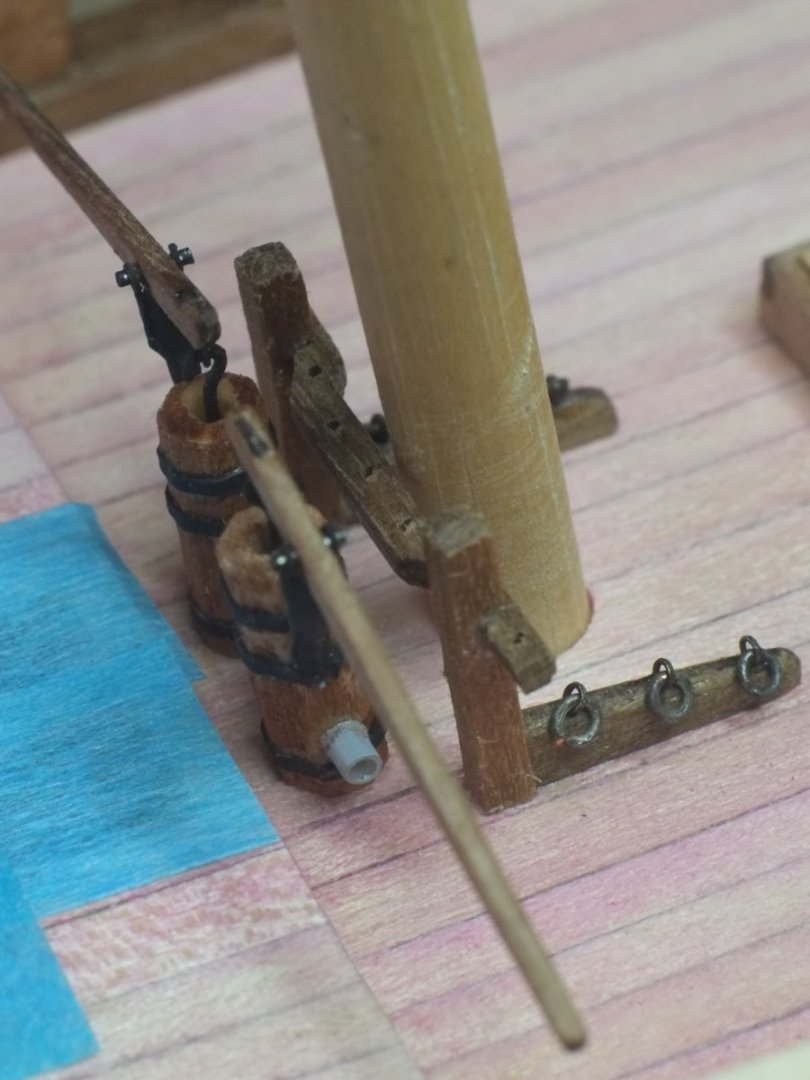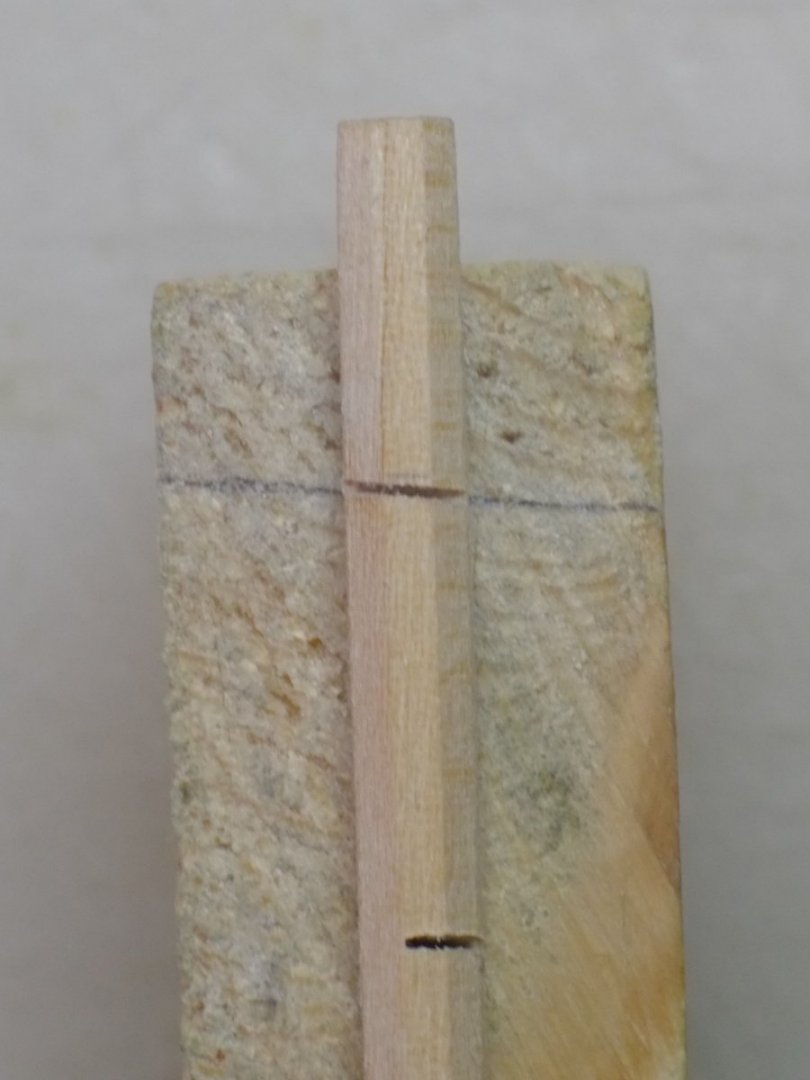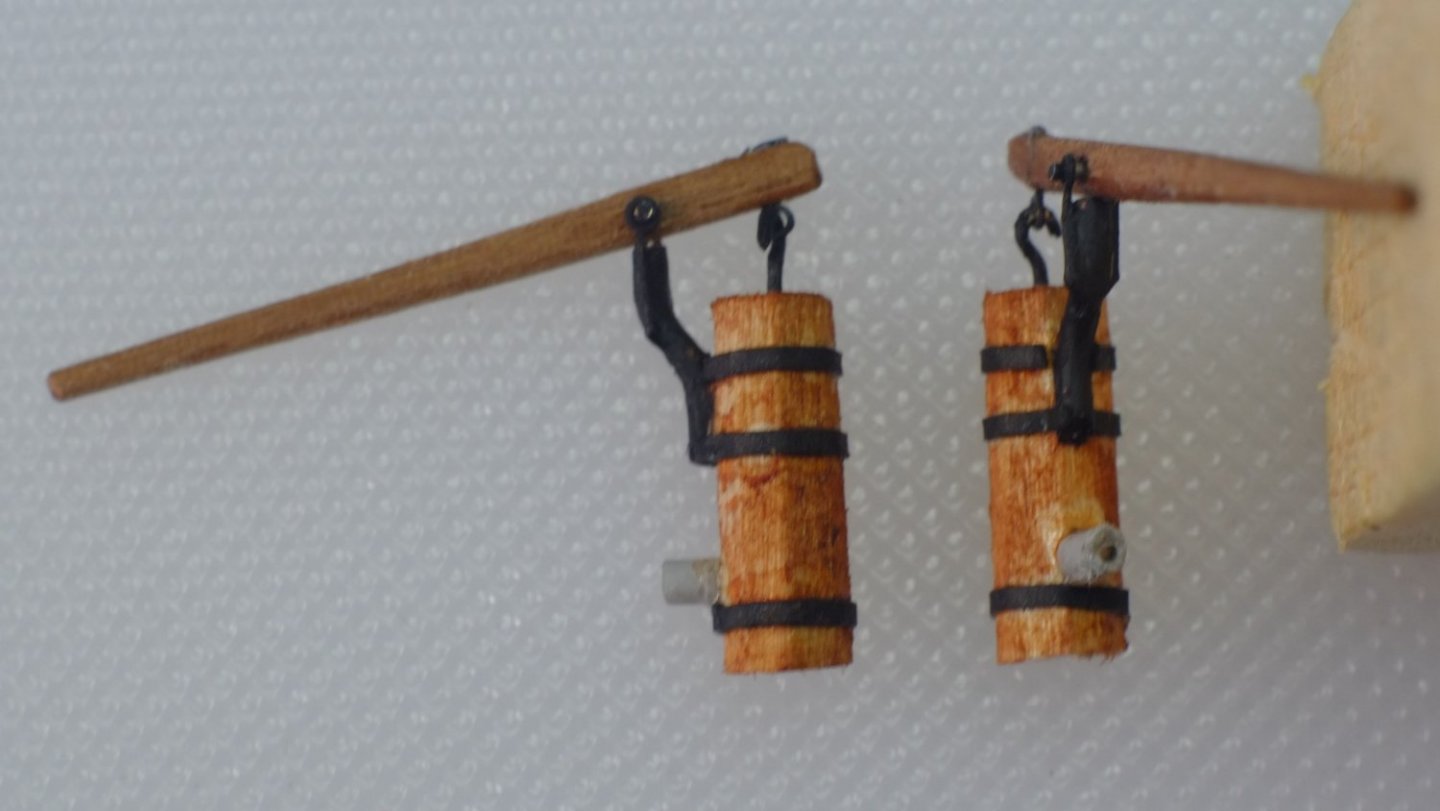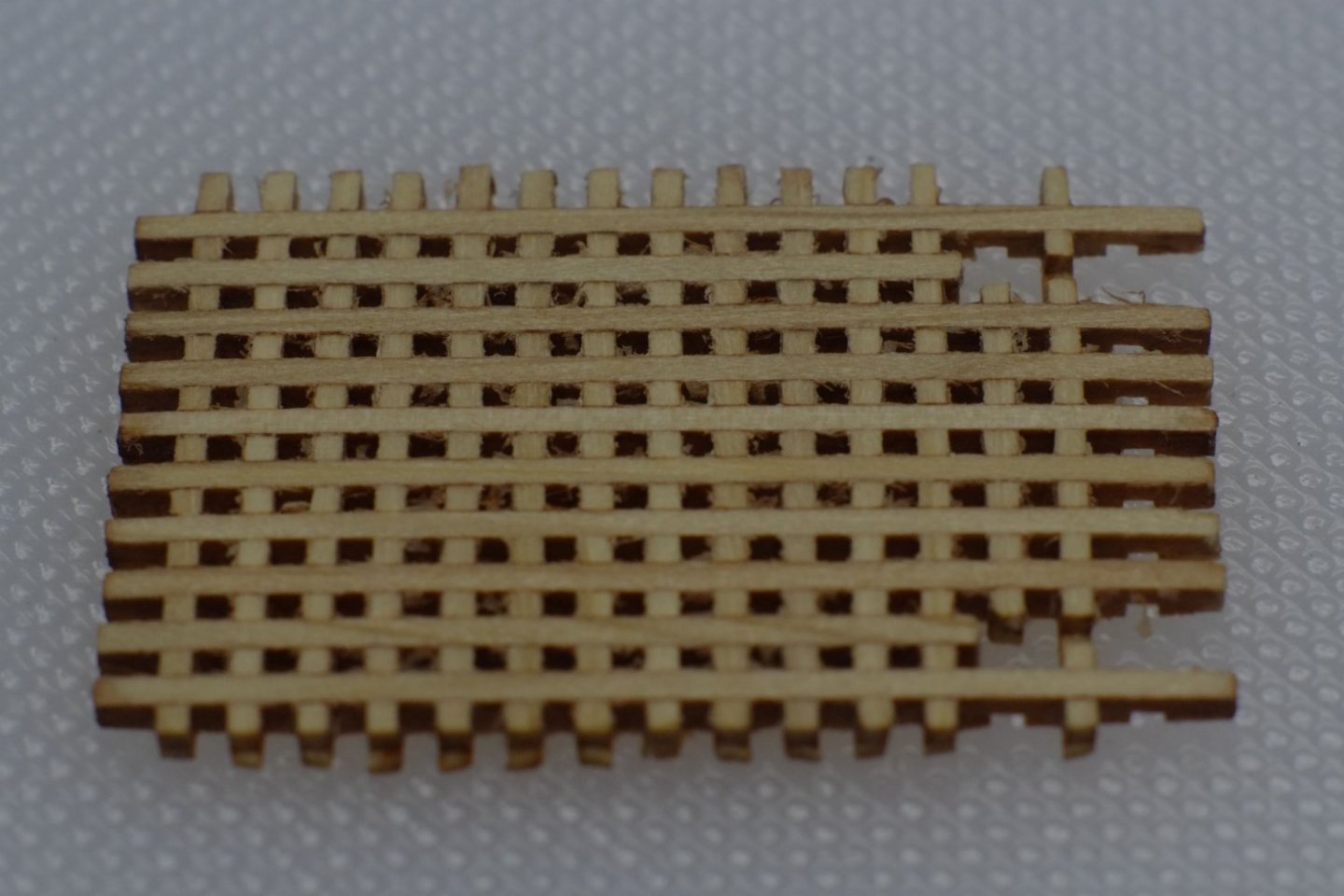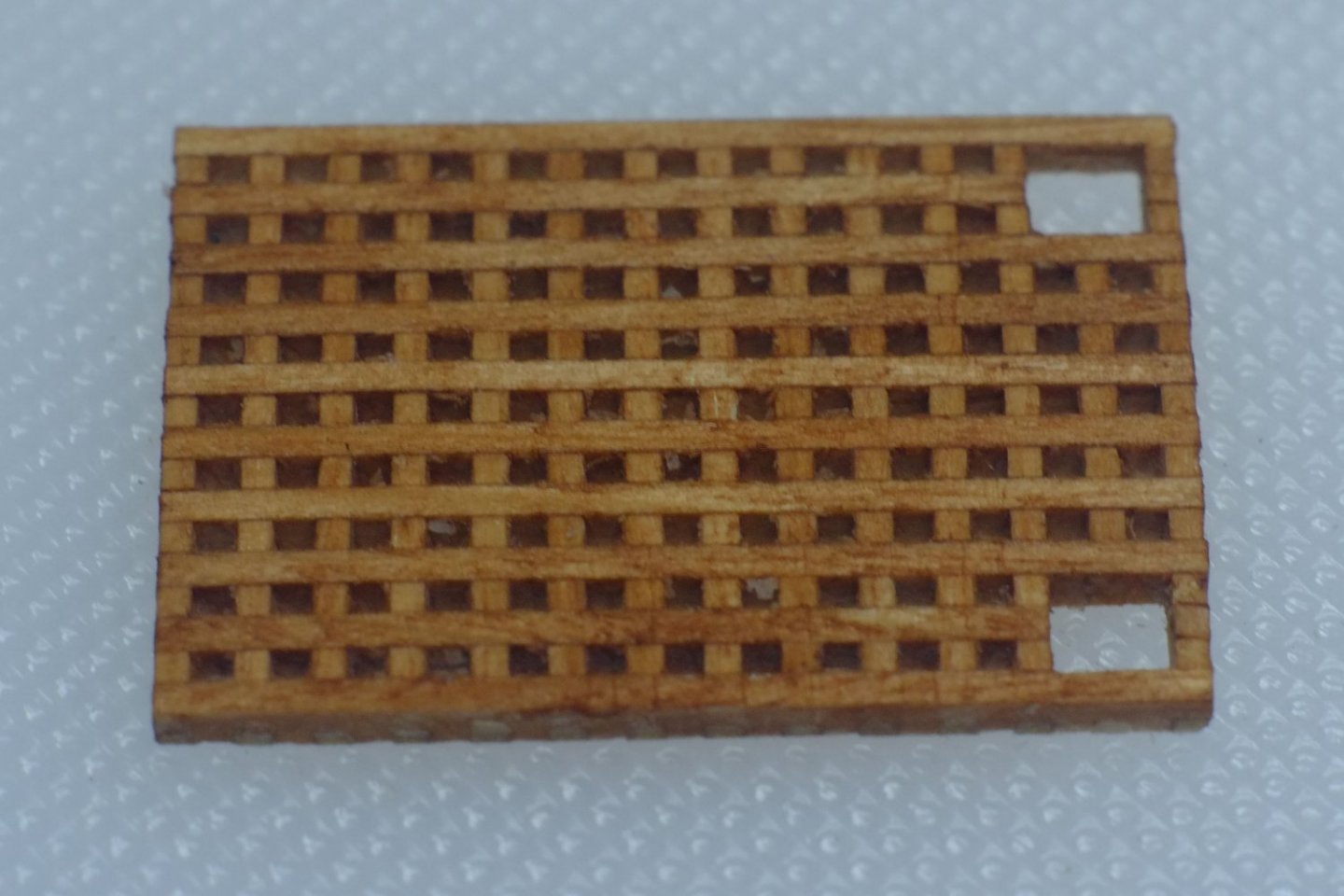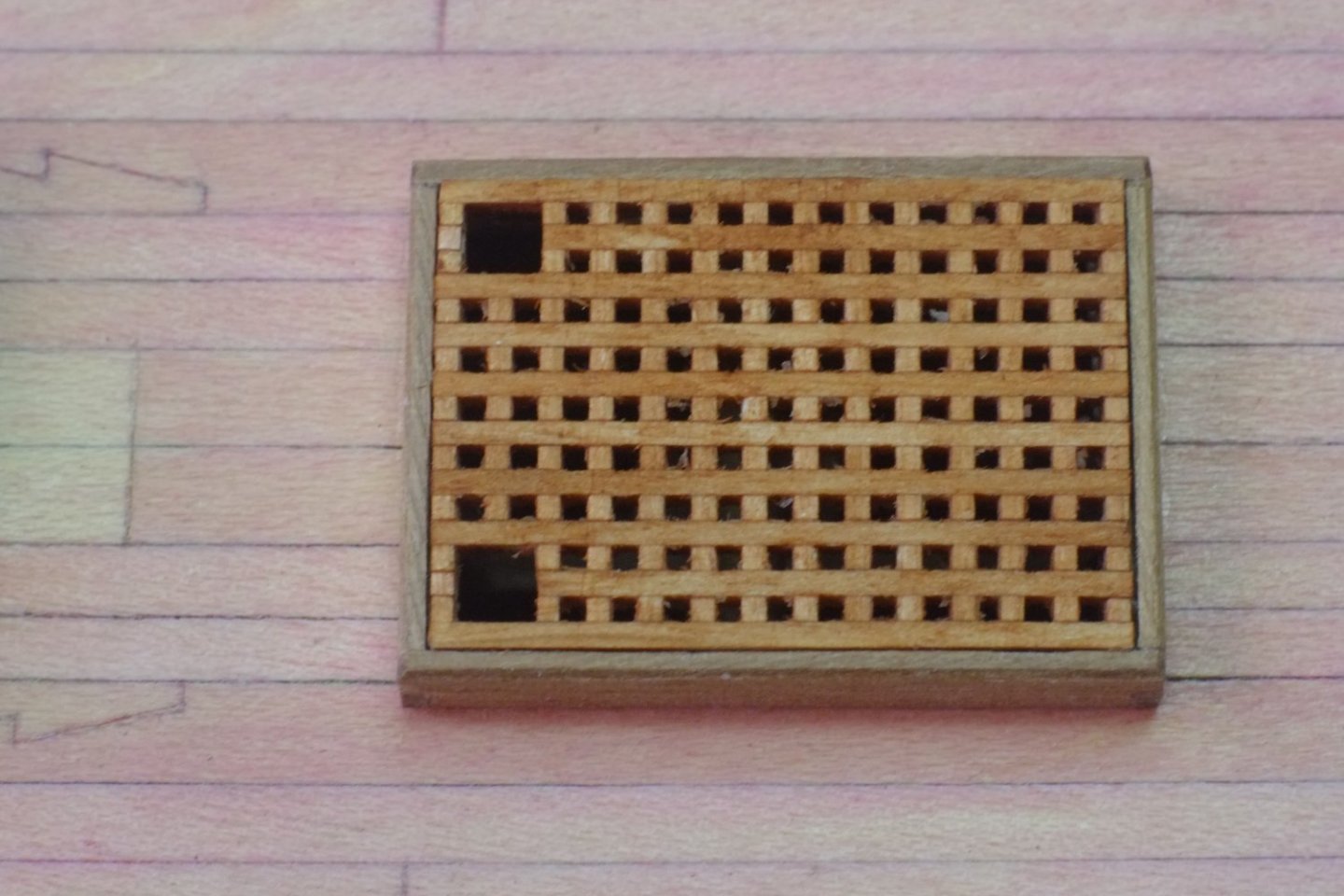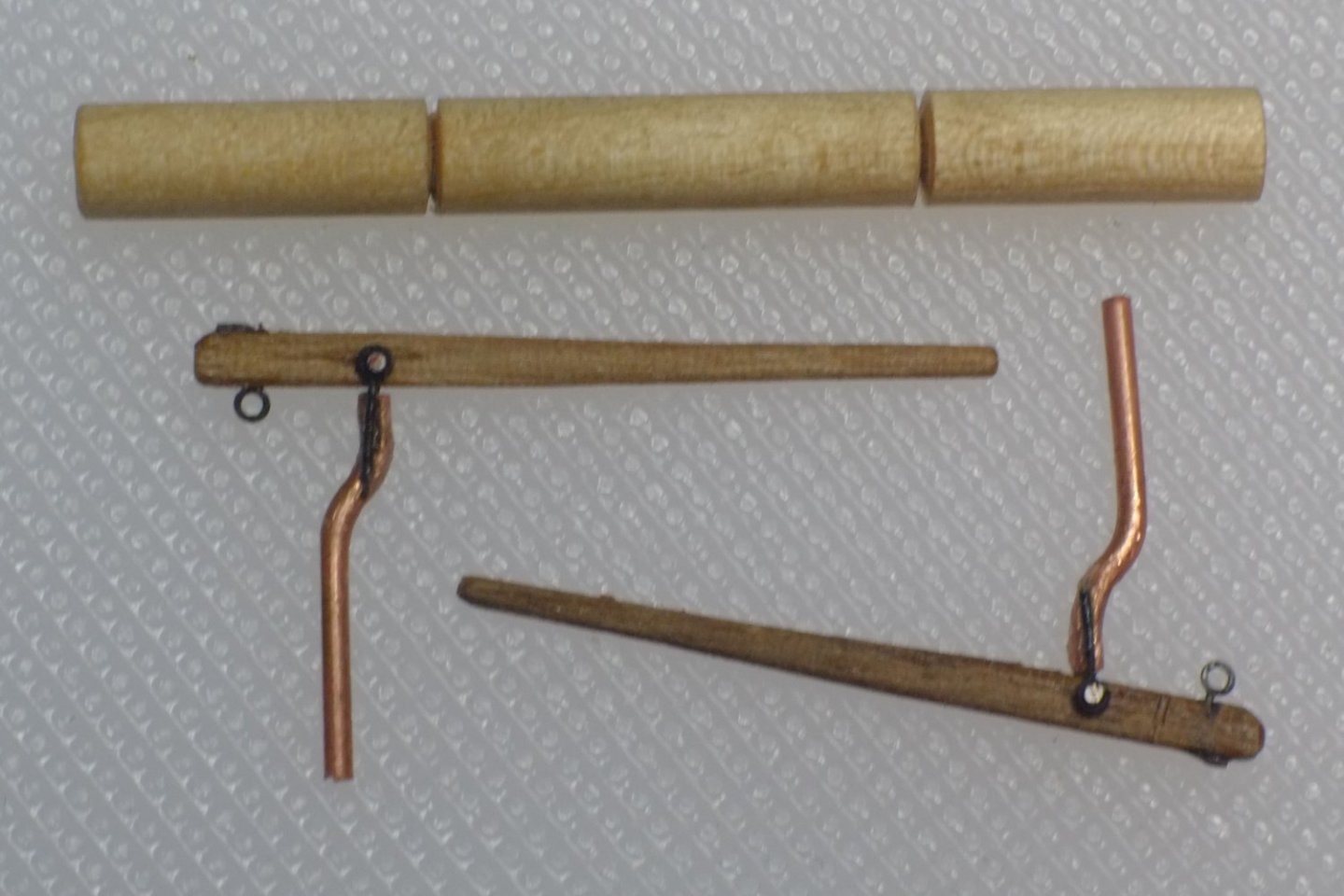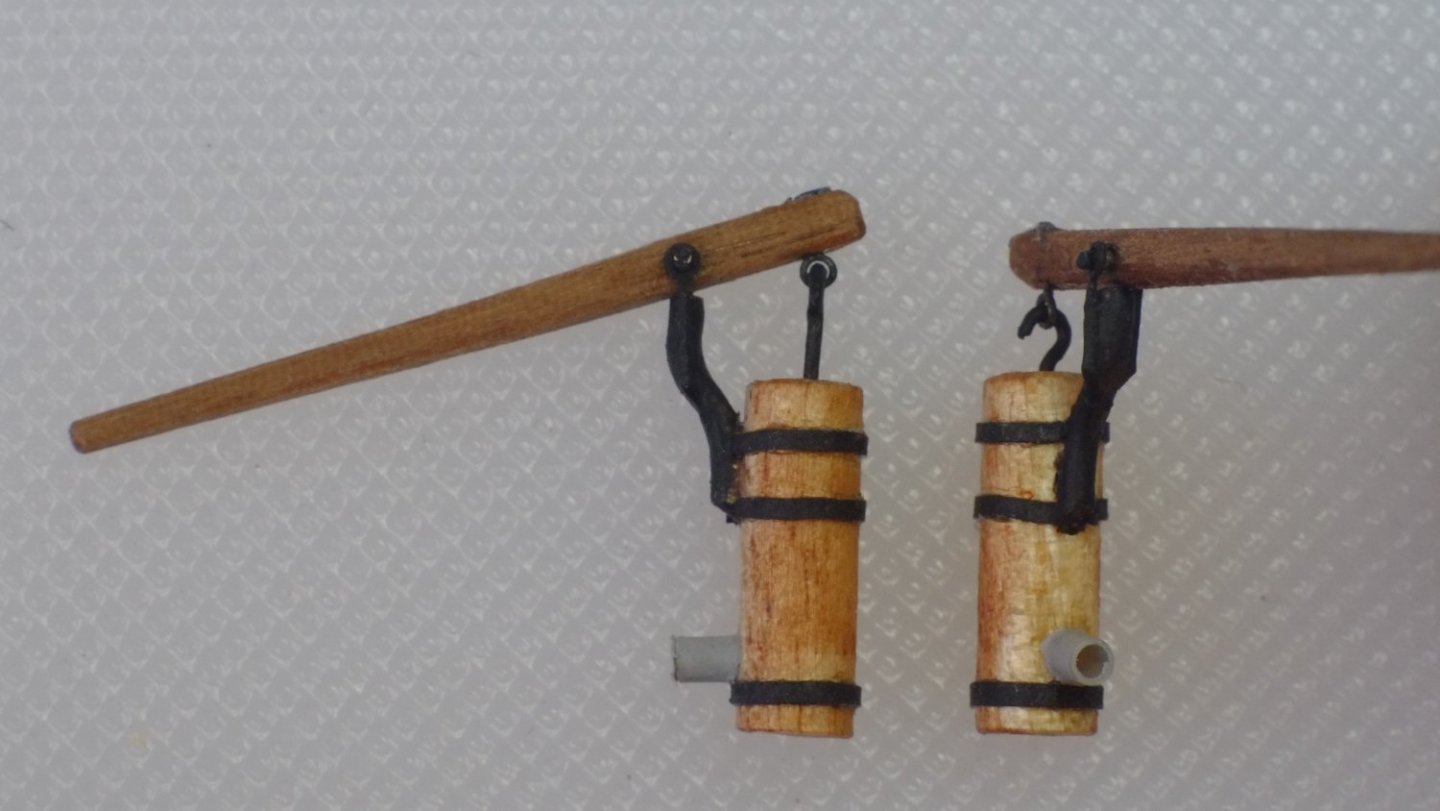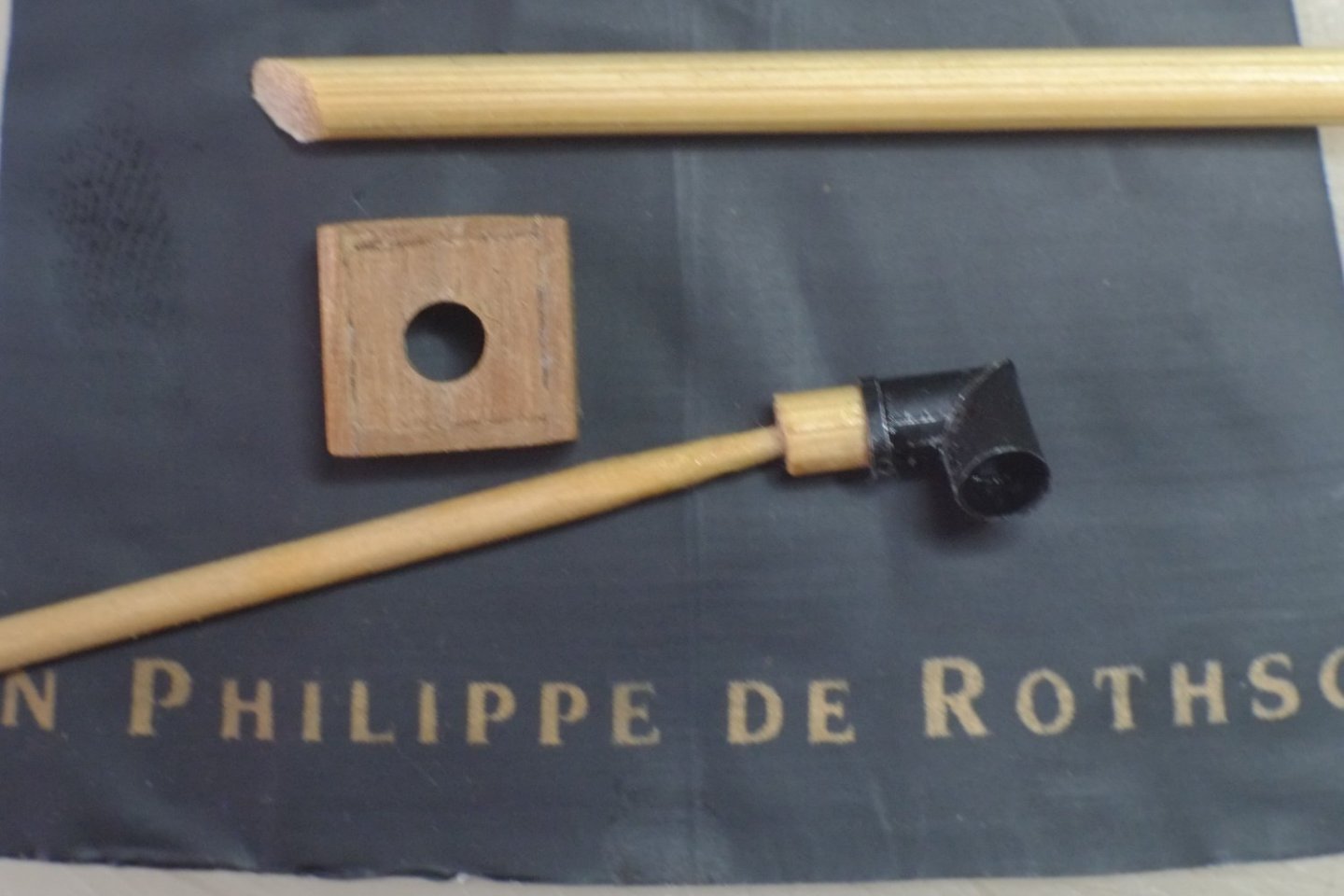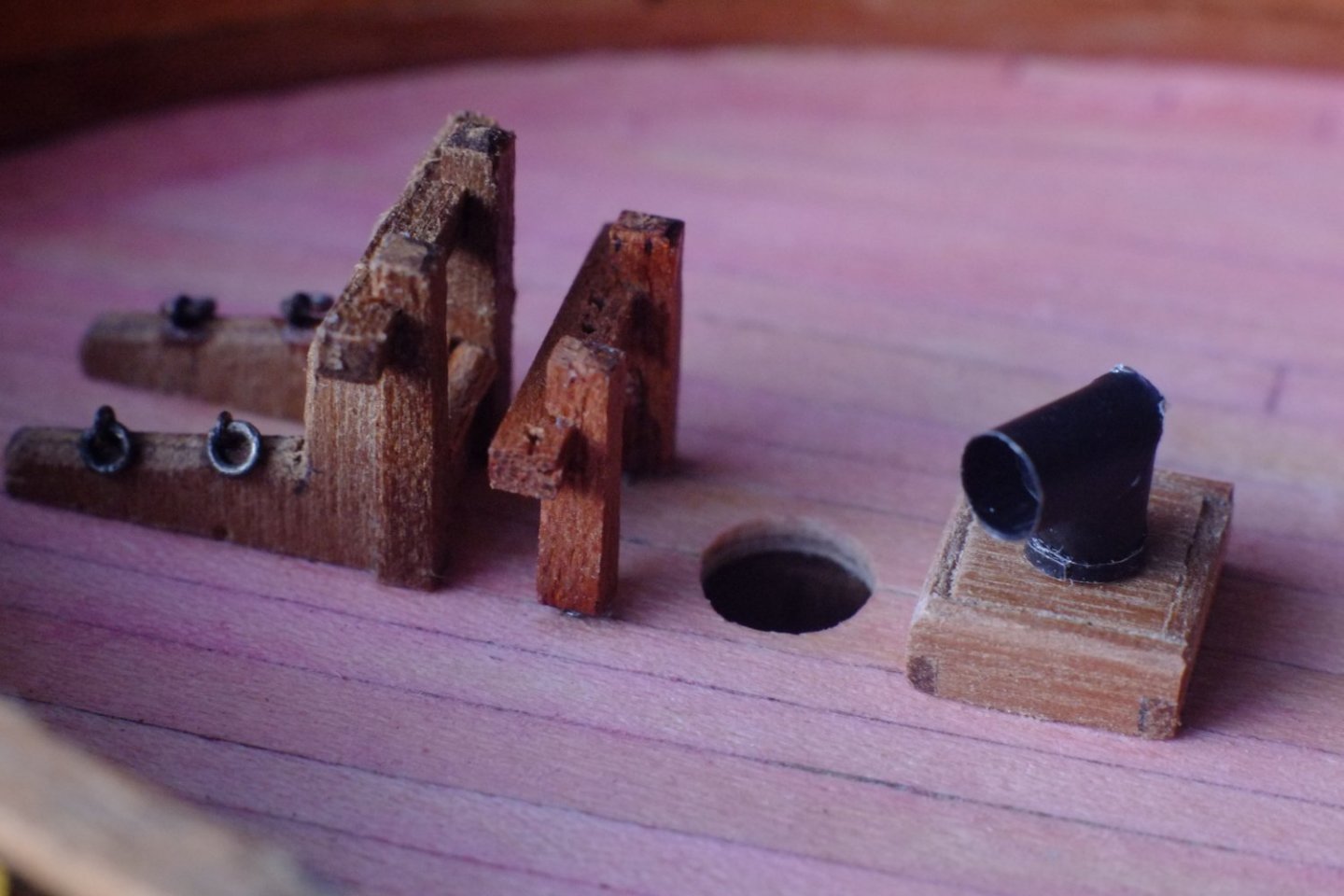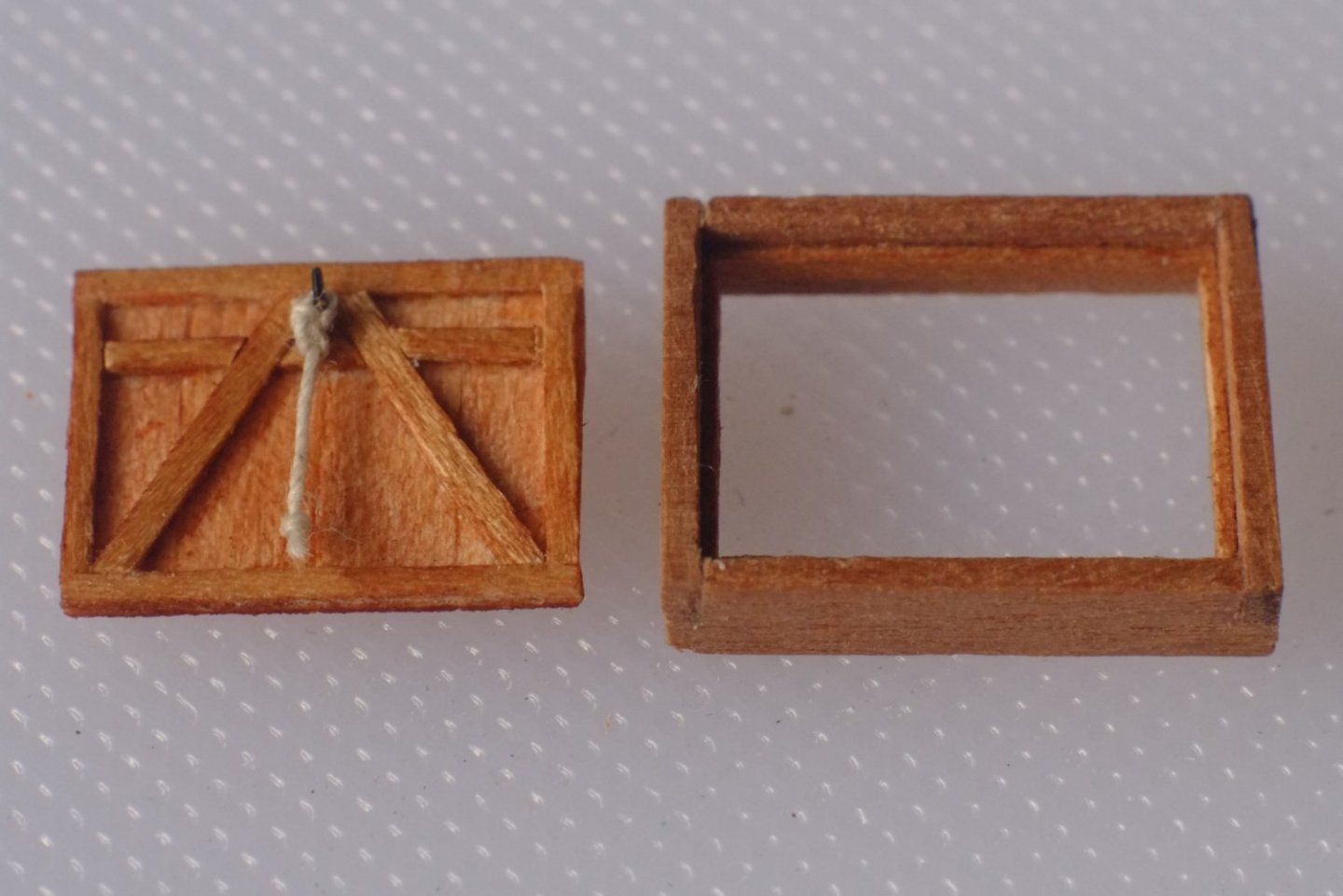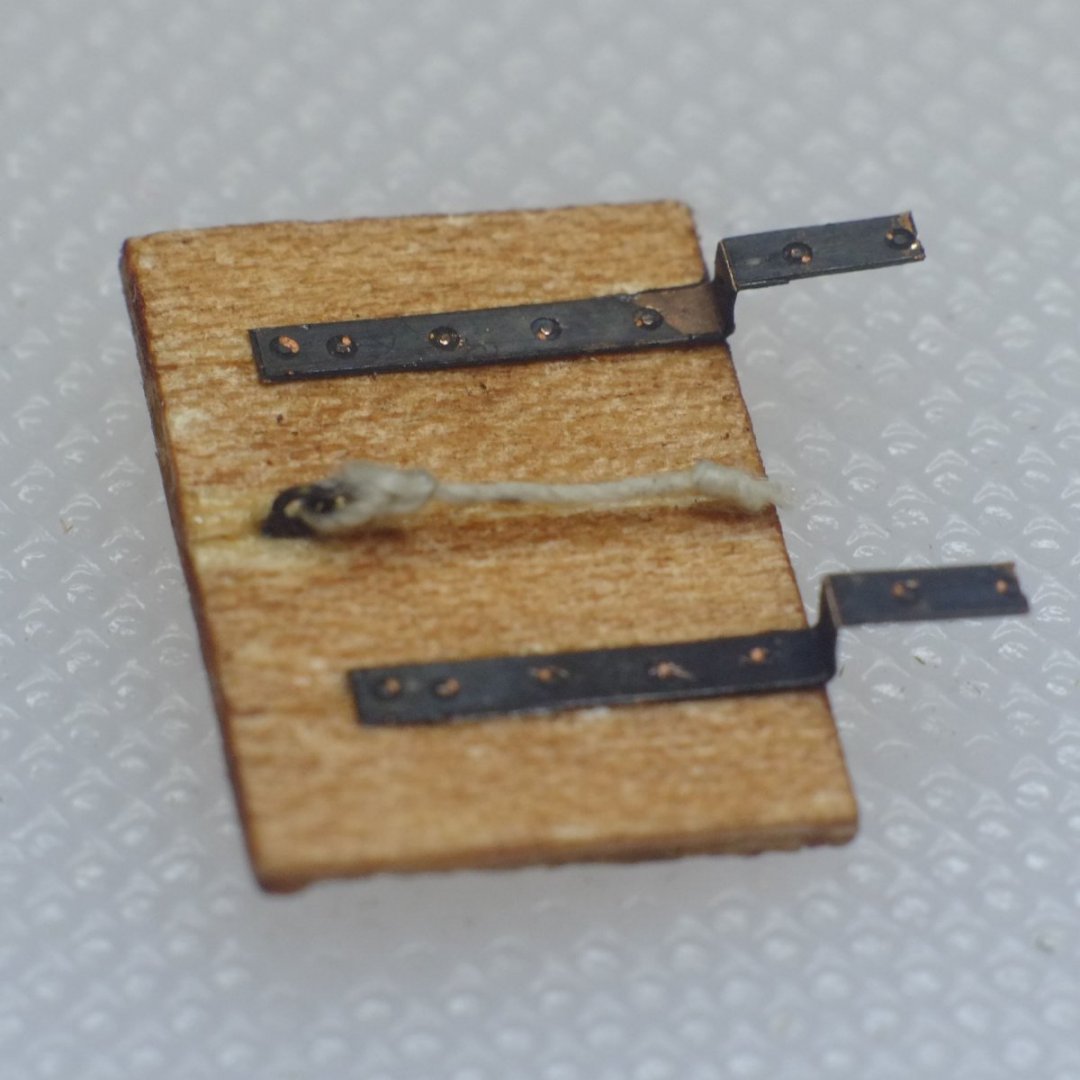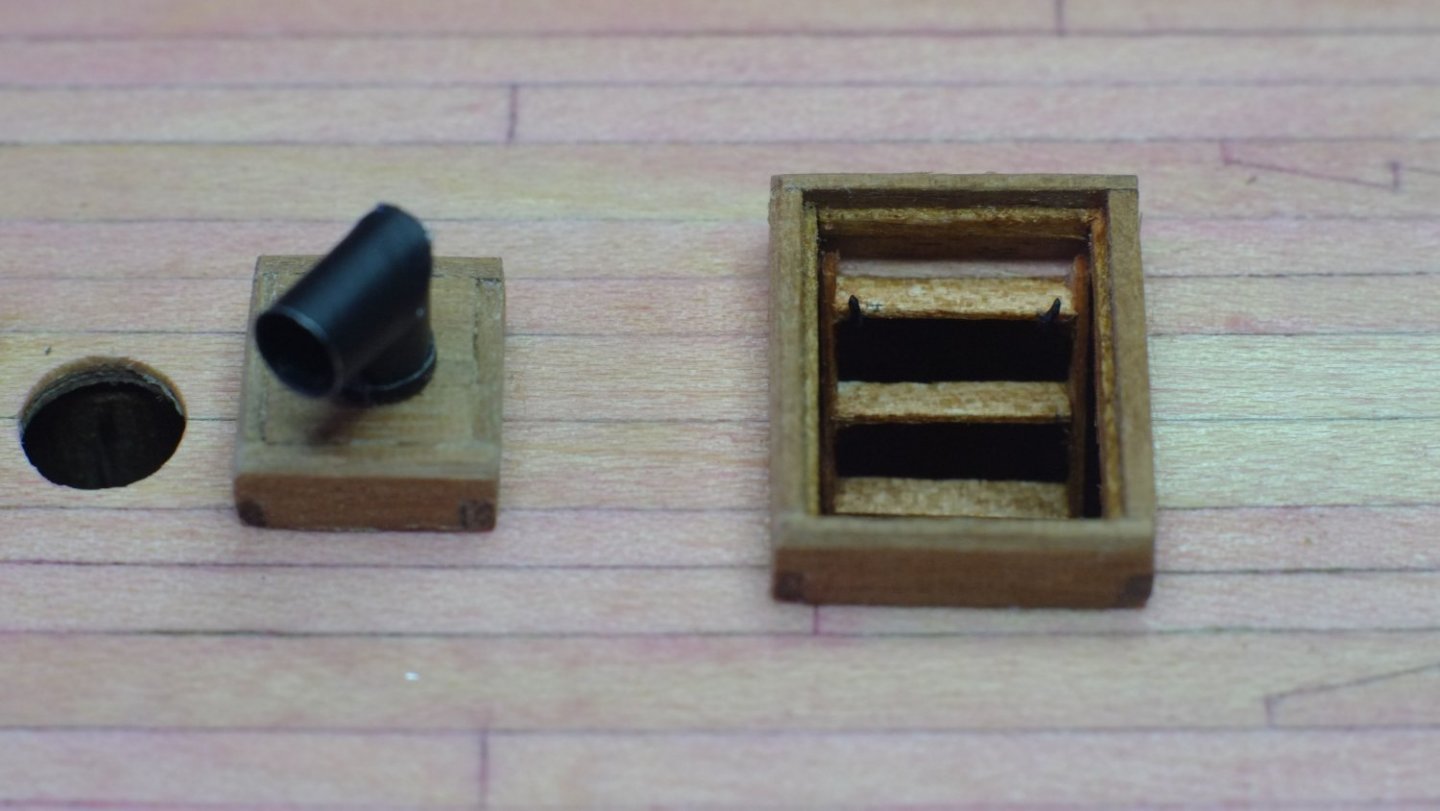-
Posts
301 -
Joined
-
Last visited
Content Type
Profiles
Forums
Gallery
Events
Everything posted by georgeband
-
I would keep going in sequence and put the garboard strake in last. It is tricky to fit the last plank wherever it sits but the garboard is, in my opinion, the less difficult to trim to shape. Be prepared for stealers now. At the bow you will find that the tapers go to a point and fall short of the stem post unless you do something smart. Similarly at the stern you will find gaps between the planks that need to be filled. Simple triangles will do at the stern or you can try to follow real practice. (If you are painting the hull below the waterline no one will know if you take some shortcuts.) George
- 65 replies
-
- Ballahoo
- Caldercraft
-
(and 1 more)
Tagged with:
-
Thank you, Tony, for your kind words and reminding us where to find the discussion about binnacles. Thanks to all for 'likes' which are a real morale booster. Rudder I described construction of the rudder in earlier posts when I was coppering the hull and it has now been finished and mounted. Tiller The tiller is curved in an elongated S shape and I made mine from a laminate of 0.5mm thick planks. The former for the laminations is from scrap ply (actually left overs from a dinosaur kit that I made with my 4-year old grandson). When the glue had set I sanded the width to get a 2x2mm section and then carved away at the back end to make a round tenon. The front merges into a circular section but it could have been square in reality. The knob at the front, which is shown on the Admiralty drawings, is from paper wrapped around the the wood. I stained the whole thing a walnut colour to match the rest of the model. Laminations for the tiller. The curvy edge in the ply former is where the dinosaur's teeth were Tiller mounted on the rudder. The grey stuff around the rudder head represents tarred canvas which stopped water going down into the hull. I used tissue paper, stained grey and glued with PVA Chains The chains were to stop the rudder from sinking if it was knocked off its pintles. The hardest part was fitting an end link in a chain into an opened ring, and an eye into the same ring, and then closing the ring. The links are 1mm long. Having fitted the chains I am now wondering if they should be brass rather than 'iron' to prevent the iron from rotting away through electrolysis. I am sure that brass chains would have been more expensive and expect that the Admiralty would have saved money in the short term by ordering iron instead, so I will leave mine black. Rudder chains, and more tarred canvas around the head of the rudder. The soil pipe below the necessary has been dabbed with grey paint to give it a duller finish George
-
That's a smart use of clips, Gregg, especially the way the spring holds the plank down. Thanks for sharing. For the planks near the keel and for the second planking there is no bulkhead to grab on to and I suggest a pin pushed into each bulkhead. If you angle the pin next to the plank it presses the plank down and against its neighbour. Don't push the pin through the plank because you risk splitting it and you also end up with holes to fill. If you go ahead with this method then put pencil marks on your first planking to show where the bulkheads are underneath them. Many will get sanded off but it is easy to do for each plank as you lay it and the remaining marks can be joined up, ready to guide the pins for your second planking. George
- 65 replies
-
- Ballahoo
- Caldercraft
-
(and 1 more)
Tagged with:
-
Pieter, Thanks for your comment about toning down the colour. I will see first if acrylic paint adheres to the foil, otherwise I will have to open up a tin of Humbrol enamel. I will try it out on some remaining foil before venturing on to the pipe. Binnacle Next piece of building is the compass in its binnacle on a stand. The standard three-compartment binnacle used in the Royal Navy looks too big and there is an interesting comment in John Roach's log book for 17 June 1806 which states 'Try'd the compasses and found the one in the Binnacle to Err one point from the other owing to some Iron thing near it'. This shows that the binnacle housed only one compass; the second was probably a boat compass in a box. An internet search for 'antique binnacle' soon reveals smaller binnacles that have one compartment with the compass and a light attached to the side. There are two varieties, one made of wood and a domed, brass one which looks like a helmet for a Victorian astronaut. (Binnacles with two iron balls on them did not appear until the 1880's.) Tony (tkay11) showed on an earlier thread that making a brass dome with a window is very difficult so I chose the wood option. This is similar to the one I made for Sherbourne years ago. The stand for the binnacle is a 15mm length of 4x4mm wood with the ends cut square. I drew and printed a compass card and glued it to one end which became the top. I used 0.5mm thick wood to build a hood with a sloping lid. The lid was glued to paper for strength before I drilled and filed a hole in it, about 3mm diameter. The paper was then scraped off and a piece of clear plastic was glued on. The lid is then glued to the hood. The one remaining wood part is a cupboard door, 0.5mm thick, that I glued to the rear face of the stand on the assumption that something would be stored inside there. The hood was stained a mahogany colour which resembles several of the antique binnacles. The stand and cupboard were stained to match most of the hull woodwork. The lamp on the side was from scrap plastic, painted to look like aged brass. The assembly was then adorned with small pieces of etched brass for hinges and clamps and handles, and black paper for feet to secure it to the deck. Front view of the binnacle with the compass card visible through the window. Rear view of the binnacle. The stand is only 4mm wide so please excuse the magnified errors George
-
A couple of photos of a scupper, inboard and outboard. These are somewhat magnified and the furry edges of the wood and other horrors are not visible to the naked eye. Scupper inboard near a step in the deck Scupper outboard just below a wale One other job I have completed is the outlet pipe from the necessary. There is a good review of shipboard toilet arrangements in an MA thesis by Simmons which you can find on the web, or just here. Seats of Ease Simmons-MA1985.pdf The pipe was usually made of wood or lead and I thought a metal one would look better. The model part started as a former in 1.5mm square section wood which had a couple of joints to take it down past the counter. I then gave it a coat of aluminium from a foil wine bottle cap which I folded around and glued with CA. A couple of brackets from the same foil make a pretence at holding it in place. The aluminium is a little bright and I might tone it down later with a grey wash. What do you think? Soil pipe below the necessary George
-
Gregg, Planking gets easier with practice as you learn the techniques that work for you. Have you been pre-bending the planks before gluing, or do you rely on the glue to hold them in place? The various build logs describe different ways of bending (dry heat, wet, or hot and wet) and the difficulties of bending a plank across its width rather than the easy way across its thickness. Have a go with the first planking and then the second layer will be less daunting. Any gaps between the planks, or between the first plank and the bulwark, will haunt you later. Glue an offcut of the planks inside the hull to cover the gap from behind and you will then be able to fill it before sanding. Better still to bend and shape the planks to close the gaps so they do not form. Tapering the planks (adjusting the width) is even more important than chamfering the edges (cutting an angle on them) to get a really tight fit. 'Bevelling' to me suggests chamfering though you might mean tapering, or it could be that the meanings change across the Atlantic. I am probably at the slow end of the speed building spectrum and some planks take me half an hour to prepare before gluing. Ten minutes for an 'easy' plank is a pleasant surprise! Take your time and enjoy the hobby. George
- 65 replies
-
- Ballahoo
- Caldercraft
-
(and 1 more)
Tagged with:
-
Pantry and necessary These two structures at the stern are clearly marked on the Admiralty drawings but there is little detail about them so I have relied on imagination and judgment to guess how they were built. The model build has two stages to it. First is making a foundation structure from ply and bits of scrap wood, second is planking the external surfaces and making a roof. I used kit deck planks (split down to 2mm wide mostly), and the roof is ply and paper painted to look like tarred canvas. The hinges and bolts were paper and oddments of wire and brass. I also tied off the ropes from the stern port lids to small cleats that I made from wire. Ply structure for the pantry The pantry, with a padlock to keep thieving hands out The necessary, with a simple latch to keep the door closed One other little job was to drill holes in the bulwark waterways for scuppers. I put one at the bottom of the step at each end of the captain's cabin and one further forward. A short length of grey plastic pipe, 1.5mm outer diameter, is a push fit into the holes and represents a lead lining. George
-
Stern port lids I have now built and fitted the port lids to Whiting. I built them as separate inner and outer layers which I glued to the ply core of the transom. The outer layers have horizontal planks and the inner layers are vertical - my guess for a simple and strong method of construction. I glued in etched brass eyes near the bottom edges, inboard and outboard, and tied some fine thread to them with bowline hitches. That was an exercise in patience and use of tweezers. The hinges are represented by strips of black paper with a short piece of wire at the joint. The holes below and outboard of each lid are for small cleats where the inside ropes will be belayed when the lids are closed The outboard ropes will be tied to the inboard cleats for neatness and so they don't go overboard. (When the ports are open I imagine they would be belayed to the cleats.) George
-
Gregg, You have discovered a common problem in these kits, which is that a flat piece of ply has to follow a compound curve. The only ways to do this are by stretching the ply (good luck with that), putting in cuts (photo below) or ignoring it which is the most common approach. Ignoring it is not so bad here because the fore-aft and side-to-side curves are usually not very pronounced. The deck profiles on the kit bulkheads have too much slope on them and the ply false deck can stand proud of them. Chris's suggestion for extra bits on the bulkheads will work if you are concerned about structural strength and is easy to do. Forward section of the false deck with slots cut in above the bulkheads to allow for compound curves George
- 65 replies
-
- Ballahoo
- Caldercraft
-
(and 1 more)
Tagged with:
-
Gregg, You have made a good start on your Ballahoo. I envy the fit of the bulkheads that you have found in your kit - in mine they were all very loose and would flap about if you breathed on them. I suggest you try the dowel for the masts and check that it fits in the deck holes and spine slots. Hopefully you will be lucky there too and Caldercraft have sorted earlier quality problems. Enjoy your build but be prepared for other design issues such as the carronades which are horrible and oversize anchors! George
- 65 replies
-
- Ballahoo
- Caldercraft
-
(and 1 more)
Tagged with:
-
Breast hook I have finished one little job which is to fit a breast hook in the bows. We know it exists because it is mentioned in the letter that accompanies one of the Haddock drawings but I have based its shape and size on what I have seen elsewhere so that is a guess. I also put in holes for belaying pins in anticipation of needing lots later. https://modelshipworld.com/topic/29694-zaz6118-schooner-haddock-drawings/?do=findComment&comment=846466 Construction started with a paper template and I carved the shape from 1.5mm ply. It needed a shallow groove to fit over the bowsprit and the wing tips had to be bent down (after a soak) so they would go under the gunwale. Breast hook under the gunwale and over a temporary bowsprit Stern ports Current job is to make the lids for the stern ports. There is a separate discussion about this https://modelshipworld.com/topic/27728-chase-gun-port-lids/?do=findComment&comment=883753 I am planning on top hinged, outward opening lids though there is not much information about any sorts of lids. George
-
Lieste, Great minds think alike! I had the same idea as you but have not seen evidence for it, and also thought of a problem: if the port lid is open and hanging down loose then it will be vulnerable to waves hitting it. Because of the leverage the force of a wave would be magnified at the hinge, which could be damaged. I have now decided on the top hinged, outward opening design. Internet searches have not shown any more detail about the Science Museum (London) model so there will be some guesswork here. Thank you all for your suggestions. George
-
Alan, Thank you for taking the time to search for a remembered drawing. There must be some interesting history behind those sketches. I have mentally explored a lot of ideas for a stern port lid. Top hinged and opening outwards has similarities to conventional gun ports and this gives it some credibility. In this situation I would have a rope on the outer face that comes over the transom and ties to a cleat 'somewhere' to hold the lid in the open position. When the lid is closed this rope would be tied to the same cleat so that the end is not lost; a sailing friend has described a cleat which has a hole in it to trap the end of such a rope. Something is needed to hold the lid shut since gravity would pull it down. A sliding bolt, or a wood bar through a hoop would do the job, or another rope tied to a cleat. I like the concept of a rope and the lid hanging slightly open because this would let water out, but a following wave would push it shut against a rebate. Thanks for planting that idea above, SpyGlass. (This all reminds me of leading 'brainstorming' sessions at work, in the days when I still worked.) George
-
Jud, SpyGlass, Thanks for your comments about aft chase guns. According to the Admiralty drawings Whiting had ports in her stern but I cannot see how they could fit guns into the tight space around them, let alone serve them. She only carried four guns (two 6lb cannon and two 12lb carronades) and moving one of them into the stern would itself have been a difficult operation with a step up and a step down in the deck on the way. I doubt if the Fish (Ballahou) class were expected to carry stern chase guns but I have no evidence for this. It seems likely but I still have to decide what to do about the port lids. As for running away upwind, that is a good plan if your little schooner is being chased by a square rigger. Whiting was not so lucky and was captured twice in 1812, by schooners, though the first capture (by an American privateer Dash) was more by subterfuge than skill at sailing. George
-
I am reviving this thread because the time is fast approaching for me to decide on the stern ports for Whiting. My thoughts are that Whiting would have ports that can be closed because of the risks from a following sea: waves could easily enter through stern ports and the water would then be trapped in a short section of deck that runs from the transom to a step up where the deck is over the captain's cabin. I also think it looks better for my model. So much for my justifications. Peter Goodwin's Alert book has photos of a cutter model 'around 1785' that was displayed in the Science Museum, London. The photos show port lids that are hinged at the top and open outwards, much like the ports on the sides of the cutter. This is the style I plan to use on Whiting. Unfortunately, the resolution of the photos is poor and I cannot discern any details. Even more unfortunately the Science Museum closed its ship models display some ten years ago and there is no reasonable chance of seeing this cutter. My plea for help! Does anyone have photos of this model which show the stern ports? Or a similar model where there are hinged port lids? Otherwise I have to resort to engineering judgment and guesswork and that is a route which is harder to defend. George
-
Mike, Just right for the period you mention is 'Two years before the mast' by Robert Dana, first published in 1840. This pops up quickly in a web search and you can get pdf or paper versions. The pdf that I have does not react to a word search so you would have to read the whole thing to find a boat hook (if there is one), but a more recent scan might behave better. The book is worth reading anyway to get a flavour of serving on an American merchant ship and sailing round the Horn to what became San Francisco. George
-
Here is a view inside the housing over the main ladder way to see the bucket and rags. Skylight The skylight (called companion on the Haddock drawing) starts with a coaming that has a sloping top. I made it from 0.5mm planks because the thickness is visible. The light at the top is from a piece of acetate on which I had scored lines to show where the framing bars would go. These are from plastic strip, 20thou (0.5mm) square section that I glued on with CA. Components for the skylight Scuttle to bread room I guessed that this would be a box hatch which has a solid lid over the opening; a grating would let in water and that is not good for the ship's biscuits. I made it from offcuts of walnut in two main parts. One is a lower coaming frame, the other is the lid that sits on it. I made the lid very slightly smaller to accentuate the join between the two. Components for the scuttle to bread room Final picture today shows the skylight and scuttle in position. George
-
Housing over main ladder way I want to anticipate questions or comments about the name of this structure which is now often called a companionway cover. Falconer's dictionary describes a companion as 'a sort of wooden porch placed over the entrance or stair-case of the master's cabin in a merchant-ship'. The Admiralty drawing for Haddock describes the skylight in the deck above the commander's cabin as the companion. So there is little agreement about the name for this glorified shed that kept the water out of the main ladder way. As mentioned in the previous post I designed my own shed and used experience from designing and building a band stand at home, together with pictures and current practice. What comes out from this little project should look reasonable and be justifiable but it does not link to a contemporary record and is mostly from my imagination. The design I chose has hinged doors at one end (starboard), a sliding roof section and a fixed roof. The roof panels pretend to be covered in canvas and tarred. The sides and doors are from vertical planks on a timber frame, and I have made guesses about bolts and hinges and handles, and rebates and overlaps to keep out the water. The photo below shows the main components. The vertical planks are about 2x0,5mm and are split down from deck planks in the kit. I edge-glued them together and then added the frames. The doors were made in the same way but with more elaborate framing. The roof panels were from 1.5mm ply which came from the frets in the kit. Main components for the shed - two sides, back end and coaming After assembly I painted the inside white. Most of the outside is stained a walnut colour except for the rails that support the sliding roof. I assumed that these would be worn fresh and gave them a pink stain. The sill in the doorway is also pink from wear. The roof panels were painted grey and I deliberately made it blotchy to simulate worn, tarred canvas. The hinges for the doors are black paper and the bolts are odd bits of etched brass. The shed with doors and roof glued open The ladder was trimmed to shape and glued into the hatch. Because of sloping floors and sides and different 'verticals' it sits at a small angle. The shed then goes over it and I allowed enough deck inside the door for a sailor's foot before he starts to descend on the ladder. At the back of the shed there is a small covered area of deck and I put a bucket in there and will probably add a bundle of cloth, ready to mop up the water when it gets in. Shed installed on deck It's only a little shed but I don't think it would have taken me much longer to build a full size one. George
-
Pumps and main fife rail in place The fife rail was not difficult, just a bit flimsy while it sat loose on my work table. With hindsight it might have been easier to finish the posts and their supports, glue them to the deck, and then attach the pin rail. This is what it looks like as an assembly. Main (aft) fife rail I glued the fife rail to the deck with PVA. The deck planks are perfect guides for alignment to port and starboard; for fore and aft I stuck a small piece of masking tape to the deck to show a line 8mm forward of the step. I also glued the pumps in place and for them I drilled holes in the deck and the base of each pump. A short piece of wire ensures that the pumps are in the right place and I only have to adjust the rotation angle of the pumps by eye. Pumps, fife rail, temporary mast, and tape over the main ladder way The photo above shows how crowded the deck is around the main mast, and there is more to come. (The kit places the pumps near the fore mast which is quite wrong.) Housing over main ladder way My current task is the housing over the main ladder way. The Admiralty drawings only show it in the side views and they have the sides parallel to the frames which makes the whole structure lean back relative to the deck. I followed this angle for the pumps and fife rail posts because it made engineering sense. However, I think I will make the housing perpendicular to the deck and consciously and deliberately differ from the Admiralty drawing. As mentioned in an earlier post this is not a decision to take lightly. https://modelshipworld.com/topic/28307-frames-built-vertical-or-perpendicular-to-keel/?do=findComment&comment=819683 The drawings tell us nothing about the other dimensions of the housing, and whether the top lid was hinged or sliding. This will be the time for some inspired guesswork and advice from knowledgeable people at MSW. George
-
Eric, Thank you for your kind words about my book. I am relieved that it reached you eventually and I can only guess at the causes of the delays - Covid and Father Christmas? Best wishes, George
- 10 replies
-
- Sherbourne
- Jotika
-
(and 5 more)
Tagged with:
-
Pumps revisited I realised after finishing the pumps that they should stand at an angle to the deck. The long body of the pumps is parallel to the frames and perpendicular to the keel, while the deck is at quite a different angle. The bottom of the (model) body has to be angled and I expected things to break if I tried cutting and sanding, so I took the opportunity to make new, octagonal bodies. The new bodies are from 4x4mm obechi which I placed in a mast-trimming jig and sanded all the corners to get an octagonal section. The new sides should be 1.66mm wide and I found it easy enough to compare the sanded surfaces with the original square sides by eye and keep sanding until they looked equal under a magnifier. This was followed by drilling a 1.5mm hole at the top end and cutting the piece to length using another fine jig. Octagonal pump body on a block of wood where I have marked the angle of the deck as a cutting guide The pump components are much the same as previously and I re-used everything apart from the paper bands around the body. The finished pumps do not look any different from the previous version at first glance but the angle and the round section would have gnawed at my conscience if I had not changed them. I did not mention earlier that the outlet pipes are in line with the handles although drawings appear to show them offset at 45 degrees. The reason is that the handles have to be athwartships (if that means they point directly to the bulwarks) because there is not enough room to have them angled forward or aft by 45 degrees. Similarly, the outlets point to the scuppers and not to the mast or the main ladderway. The sailors could expect wet feet when pumping. (Almost) finished pumps: the outlet pipes need to be cleaned out I am now working on the aft fife rail. This is a curious beast with uprights that are perpendicular to the keel and not the deck (sounds familiar?) and a pair of stanchions to support them. The rail itself arcs out from the posts; I suspect that one reason for this is that the deck is quite crowded and a straight rail would interfere with the mast. George
-
More deck furniture Main hatch and grating The main hatch has a grating over it and I used the 'combs' supplied in the kit. It is better to have extra length of comb beyond the size you want if, like me, you tend to round the edges when sanding. I left two open squares at one end for anchor cables to go down to the hold. (The kit shows navel pipes for the anchor cables but they are unlikely in this period.) After the glue had set I sanded down the thickness from both sides, the reason being that I want the interior lighting to be visible through the grating. Grating sanded down to 1mm thick. The combs are over-long at this stage When the thickness was correct I trimmed off the sticking-out bits of the combs, opened up the holes for the anchor ropes, and filled in a few slots in the combs that were left open because of the anchor holes. I gave the assembly a light brushing of wood stain (water based dye) to hide the bright white wood. Grating complete The coaming was built to fit the grating; I wanted the edges of the grating to be complete lengths and not a 'comb' which can happen if you start with the coaming. I used 1x4mm walnut and made simple overlap joints. A little sanding ensures that it sits flat on the deck with no gaps. I glued a ledge inside the coaming (1x0.5mm wood strip) to support the grating so it sits just proud of the coaming. I glued the coaming to the deck but left the grating loose for now in case I need to have access to the insides later. Grating and coaming on deck. I have spent what seems like hours cleaning out the holes in the grating but there is always some detritus in them. At some point I will have to say 'enough'. Pumps The drawings that I have found of pumps all follow the same basic concept but differ somewhat in the detail. The pumps in the kit and those available as after market components looked clumsy to me so I chose to scratch build a pair to my own design which looks plausible though I cannot point to a reference to justify it. They are fiddly because there are small parts to make and assemble but nothing too difficult. The body of the pumps is from 4mm dowel and 12mm long. The Haddock drawings suggest an octagonal section but I chose to keep mine round. I drilled a 1.5mm diameter hole at the top end. The handle is 28mm long (6 feet in scale) and I cut mine from 1mm thick walnut. The height/depth of the handle is 2mm at the pump end and 1mm at the sailors' hands. Other parts are copper wire, etched brass eyes, black paper, plastic tube. Pump components. Dowels and wires are over length to make handling easier Pumps finished and ready The pumps went into the box of finished parts and will be installed later. George
-
More deck furniture Working my way aft and avoiding the breast hook, the chimney came next. The housing is a simple box with a hole in the middle and the chimney itself looks like an open topped pipe on the Admiralty drawing, but I chose to give it an extra cowl to keep the rain out. I made the chimney from black aluminium foil (mine came from a very nice bottle of bubbly) with a bamboo barbeque stick in the middle as a former. It was a bit fiddly but I like the end result with black and exposed metal; the inside of the cowl needed a smudge of black paint to hide the aluminium. Work in progress on the chimney (other bottles of wine or bubbly also have black foil) Chimney fitted aft of the fore mast The fore ladderway came next. I had made the ladder previously from 2x0.5mm deck planking and stained it. The coaming is from 1x4mm walnut with overlap joints and has a ridge on the inside to support the hatch cover. The cover was made from strips of 0.5x4mm deck planking glued edge to edge, and then I fitted a frame to the under side. The shape of the frame was from imagination and a bit of practice making doors and gates. The mock hinges that hold the hatch cover to the aft end of the coaming are cut from copper plates and were chemically blackened. I added a rope on each side of the cover, tied to an eye with a bowline hitch and with a stopper knot at the end. The cover will be attached later when it will not be so vulnerable to getting knocked. Coaming and inside of the cover for the fore ladder way Upper face of the hatch cover with mock hinges Ladderway and coaming set aft of the chimney. There are a couple of mock hooks under the top step of the ladder to stop it sliding and falling... The hatch cover is safely stowed for now. George
-
The 12ft cutter I ordered on Friday arrived today (Tuesday) and is a beautifully crafted, delicate model. Like Glenn (glbarlow) says above it takes away the need to make a difficult extra on a larger model and I was bracing myself to scratch build a clinker hull out of thin card. I will still have to make the insides and the oars but that is a minor issue compared to the hull. Well done Chris for providing these extras. George
About us
Modelshipworld - Advancing Ship Modeling through Research
SSL Secured
Your security is important for us so this Website is SSL-Secured
NRG Mailing Address
Nautical Research Guild
237 South Lincoln Street
Westmont IL, 60559-1917
Model Ship World ® and the MSW logo are Registered Trademarks, and belong to the Nautical Research Guild (United States Patent and Trademark Office: No. 6,929,264 & No. 6,929,274, registered Dec. 20, 2022)
Helpful Links
About the NRG
If you enjoy building ship models that are historically accurate as well as beautiful, then The Nautical Research Guild (NRG) is just right for you.
The Guild is a non-profit educational organization whose mission is to “Advance Ship Modeling Through Research”. We provide support to our members in their efforts to raise the quality of their model ships.
The Nautical Research Guild has published our world-renowned quarterly magazine, The Nautical Research Journal, since 1955. The pages of the Journal are full of articles by accomplished ship modelers who show you how they create those exquisite details on their models, and by maritime historians who show you the correct details to build. The Journal is available in both print and digital editions. Go to the NRG web site (www.thenrg.org) to download a complimentary digital copy of the Journal. The NRG also publishes plan sets, books and compilations of back issues of the Journal and the former Ships in Scale and Model Ship Builder magazines.




